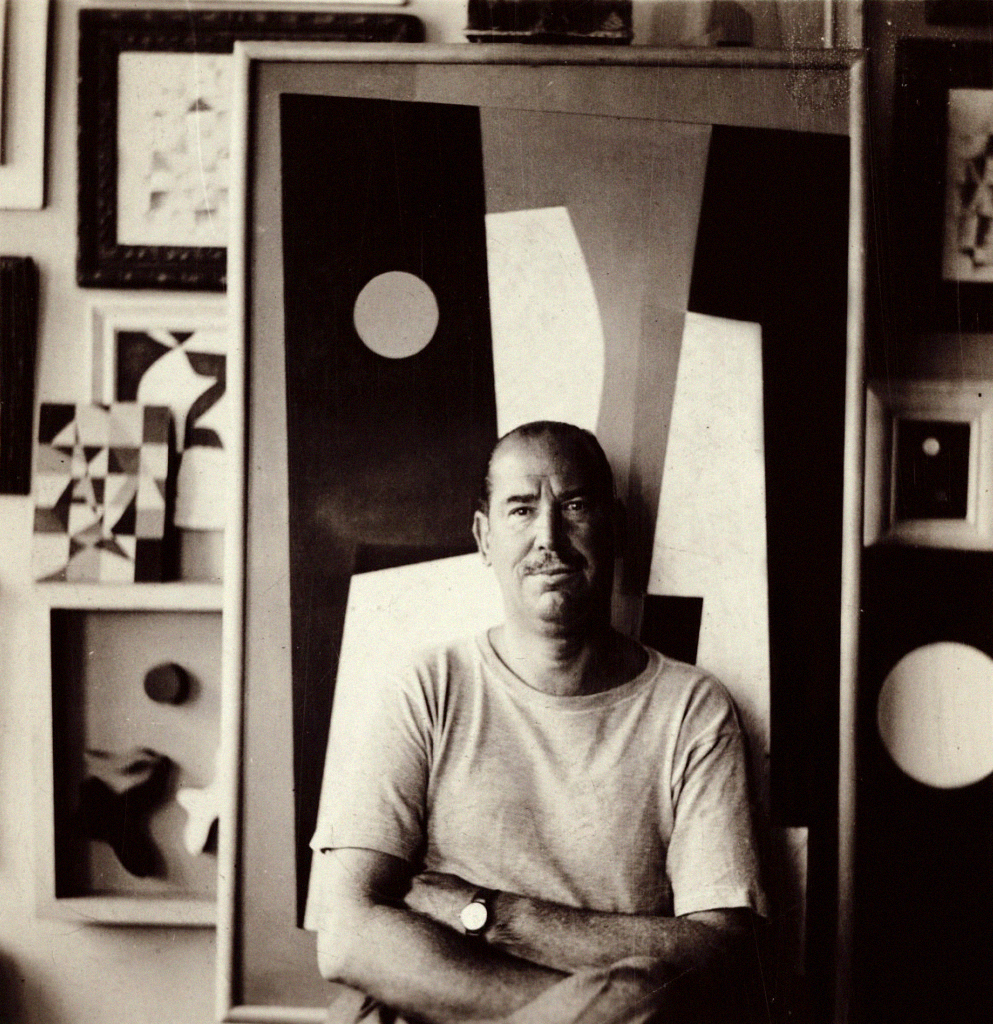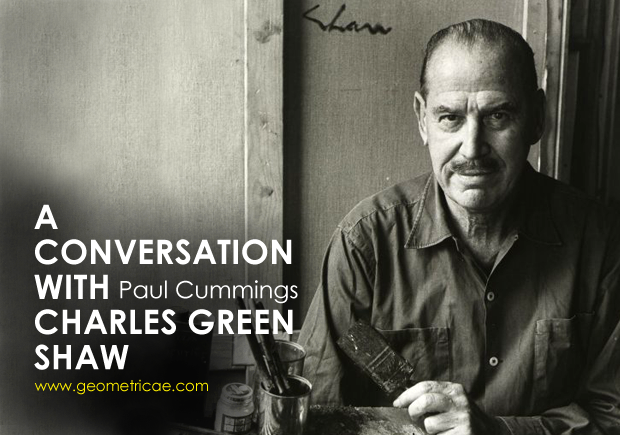Oral history interview with Charles Green Shaw, 1968 April 15. Archives of American Art, Smithsonian Institution.
Interview by Paul Cummings
You were born in New York in 1892?
Long time ago, eh? You don’t realize but that is the fact.
Could you tell me something about family background, where you lived in New York?
My earliest memories go back to a place called the “Florence.” The “Florence” was on the corner of Eighteenth Street and Fourth Avenue and it was a family apartment hotel. And on those corners there were four: the Florence, the Clarendon, the Belvedere, and another one whose name escapes me. It was all purely residential in those days.
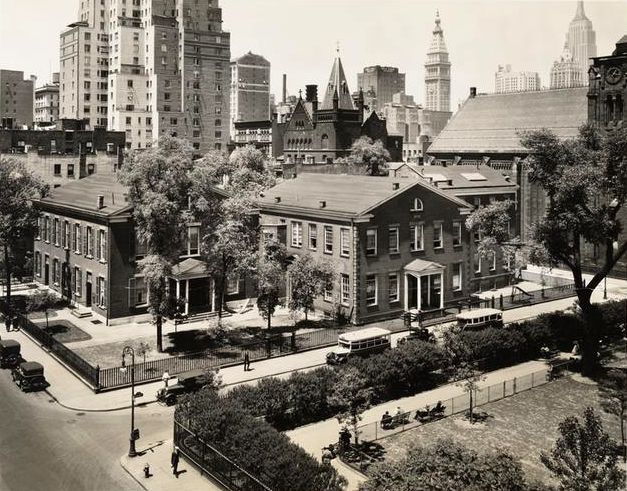
But they were hotels?
Apartment hotels. The Florence had a restaurant so you called it a hotel. And I lived there with my father, uncle and grandmother. When I say I remember the early facts of my life it would have been about five. I lost my mother when I was three so I don’t remember her at all. And we lived there until my grandmother died in 1902, I think it was, and then moved uptown on the west side for awhile. To go back to the early days on Eighteenth Street, I went to the Friends Seminary that is still there and looks exactly the same as it looked in those days. The same playground. The only thing that is not the same is where the football field was, not a very big field, now they’ve added school rooms on that space. That was on as it is now, Stuyvesant Square on Sixteenth Street and is exactly the same from the outside.
It hasn’t changed a bit. Do you remember about how long you lived there?
I imagine I must have been two or three. I was born at the Grand Hotel. That was on Broadway and Thirtieth Street but I don’t think I was there very long and I think I was in the Florence from say 1894, 1895 to 1902. Then after the Friends Seminary I went to Berkley School up on Seventy-second Street and West End Avenue. And after that I went to Yale.
Could you tell me something more about your father?
Well, both my father and my uncle had retired in those days. My uncle had been a lawyer, my father had been a merchant, not in New York though — in Cincinnati. And he had retired and my uncle had retired, too. Now I feel frankly that much of my education that mattered, that stuck with me was found and formed in the library of our house there because they had a very good library and all kinds of books to read. And I read a good deal even before going to school.
What kind of books did you read?
All kinds, every kind. Classics particularly, and history and illustrated books, poetry. All kinds of things. And in that process I thought often afterwards that there are a lot of things that you never learn at school or college. Never.
Yes, that is true.
And I’m not sure today even. I am going to say this and I think today is a sad commentary from my point of view, that a family is so important to the child. There are so many things schools cannot teach or assume that they should have been taught before, they don’t bother about. And today the child has a pretty rough time at home, I think.
They have television. Which has replaced the library and thinking and too many other things.
Too many other things.
So you had a lot of books to read and started reading at an early age?
I started reading at an early age and also I started growing at an early age. If you would be kind enough to reach there, the very farthest right. Here is a book that was brought out by — my uncle collected the pages and it was done at the age of nine and I think I began drawing at the age of six.
“Costumes of all Nations.” Where did the illustrations, the ideas, come from? From books?
From books, yes.
Do you remember if they are copies of specific things or things you made up? Adaptations.
I think the Chronicles of Floorsire (sounds like) was one. That is the only one I can think of specifically with a combination of various books. You see, that makes it the historical side for one and the fact of drawing for two.
You had color, too?
Color, too.
That is when you were nine?
That is right.
Nine years old. That’s about the earliest adventure in drawing.
That must have been before that but I don’t recall. Those probably were done when I was seven and eight, you see.
It was put together when you were nine.
Yes. My memories don’t go back awfully far. Some friends of mine say they remember from when they were two. I can’t.
I suppose in school you had the same kind of curriculum as the other students?
That is right, the same exactly. Absolutely. Friends Seminary was the first.
That was sort of kindergarten age wasn’t it?
No, it was called Primary. I think it was nine until eleven when I was there. They had it right up to college and they still do but I went there with my brother for only two years. But it was nice and very all right.
You only have one brother?
That’s right. Nobody else.
You lived with your father and your uncle and your grandmother but after you moved…
Then I went to Berkeley School and was there for about five years I guess. At Yale I thought of going to the art school but I decided to take a scientific course which I did. Took a scientific degree but after that I went for a year to the School of Architecture at Columbia.
What kind of science degree did you get?
That was in those days and it may or may not exist any more, it was a semi-scientific course. A lot of science heaven knows but there was also quite a lot of non-science. Languages, French, Spanish, history, English literature.
What was that degree for? I mean that did it lead to?
Just as general education. It was about the same as an AB.
Oh, I see.
It was about the same but more scientific courses. That is the only difference really, and no Greek or Latin. But instead of the Greek and Latin there were scientific courses. Whether that exists I don’t know anymore. That was the Sheffield Scientific School at Yale but I don’t know if the school exists. I don’t think so.
You went to Berkeley School. Was that a large school?
No.
That was all boys, right?
All boys.
You had really a masculine background.
Absolutely.
Were there any art activities or anything like that when you were in school at that point?
Well, there were drawing lessons that were all right and I was very complimented and all that sort of thing. At Yale I was on the Yale Record which took a certain amount of work and that was my undergraduate experience in terms of art.
I am just curious how you decided to do the scientific studies when you already had an interest in art. Or was that a parallel interest that was going on?
No. Frankly, I was never very interested in scientific studies or mathematical ones. They embraced a quite a lot of mathematics such as trigonometry and calculus none of which I remembered at all a month after I passed the exam or had any cause to use it since.
From Yale you went to Columbia School of Architecture. Did you get a degree in architecture?
No. I was only there a year. The war came on and I joined up and went overseas eventually.
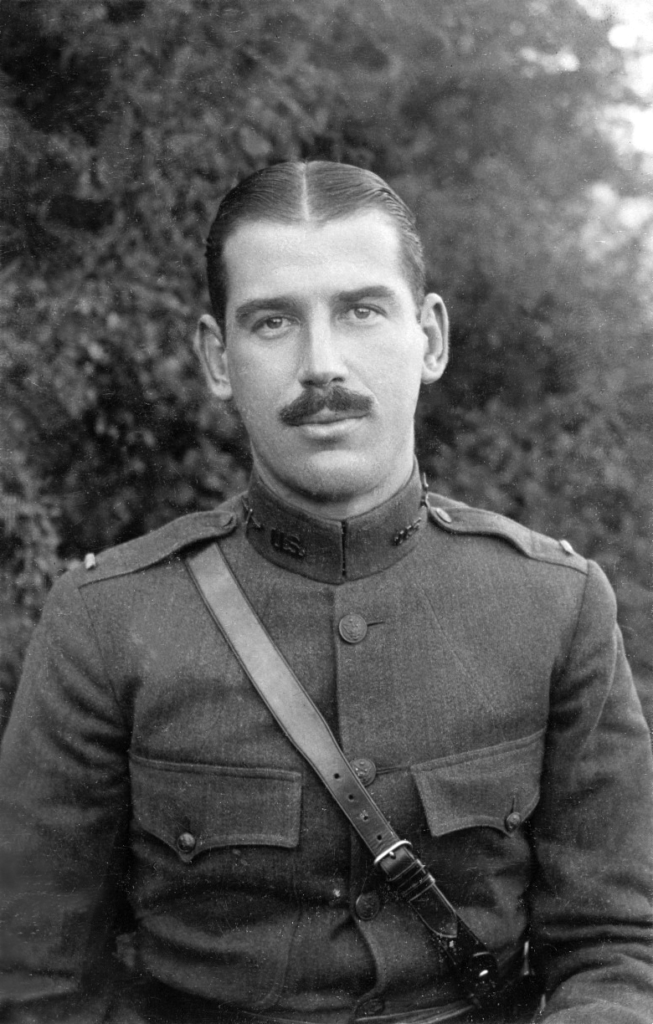
You were in the Army?
I was in the Army and after that I was commissioned at Kelley Field, Texas, in the Air Service.
Oh, really? That is pretty early air service.
Pretty early.
What did you do?
Well, most of the time I was on the ground. I was a supply officer and I was in England most of the time, too. I remember the first trip I made up the chap looped the loop. Open cockpit flying.
Did you do much flying during that time?
No. I did very little flying.
But that was an exciting part to be involved with. How long were you in England?
Eight months, I guess.
Did you get to the continent?
I never got to the continent. Waiting every week to go, that’s the Army game. And waiting, waiting at Kelley Field to go somewhere.
How long were you in the Army altogether then?
It seemed about a century. I guess, it was about a year and a half,
And then you came back to New York after that. You must have been about twenty-four, twenty-five.
That is right.
I would like to get some more family background material. You went to the Friends School, did you have a Quaker background?
Yes and no. My people in the early end of the 17th century were Quakers and I suppose the reason they came here. For persecution reasons and that sort of thing or freedom and they settled in Pennsylvania for awhile. Whether any relations are there or not, I don’t know, but they were originally Quakers. But the reason I went to the Friends Seminary was because it was a good school and it was convenient.
Did you have any religious education or other than that?
I can’t say that I did. No.
You didn’t have any languages at home besides English did you?
Yes. In those days there [were] such things as governesses and I had German governesses that did their best to make me learn German. Some I took a great dislike to. But my uncle spoke very good French and German too and I think I learned a bit from him. I knew the Greek alphabet by heart and I did a certain amount of Greek translation at eight. I forgot it later. No, I didn’t forget it completely.
It didn’t get used.
That’s right.
Well, did you learn much French and German?
Yes, I learned quite a bit. See, after we had moved uptown with the family we would go abroad every summer. And in those travels I picked up quite a lot. Not much German but French certainly.
Do you still speak French or read French?
I read it occasionally and I speak it occasionally. It is pretty bad now but if I went over to Paris again I could brush up I know. And at college I took French.
You started traveling very, very young.
Very young, yes. And I can remember it awfully well, too. Heavens, what a different world it was in those days. Things were awfully different in every way but we had a car and the car would stop in a little French town and you would think that we had come in on a dinosaur.
When was the first time you went to Europe? Do you remember how old you were?
I would say about 1902, 1903,
Then you were ten years old. Have you had many trips to Europe?
Yes, A great many. But I lived in Europe, too.
Oh, you did?
That was in the thirties. Late twenties and thirties. I lived in Paris and London. That is really when my painting career started. It really started I would say in ’29.
What did you decide to do after the Army?
I went to Columbia not because I expected to be an architect because I always felt architecture, from my point of view, was much too mathematical. I was interested in interior architecture, but for one reason or another that didn’t seem to pan out, so I started writing. I have written more or less ever since, as well as paint. From 1920 or before until 1930, I wrote hundreds and hundreds of magazine articles.
You wrote for Vanity Fair and…
Vanity Fair and Smart Set, George Nathan, Henry Mencken and for the New Yorker and two or three others. And during those years I think I published half a dozen books.
What kind of books were they?
Well, all kinds. One was biographical sketches, a couple were novels, one was on New York. Then I went abroad. For a while I wrote abroad but I really then began to paint exclusively until I came back to live in America.
All the magazine articles were fiction and things like that?
Pretty much so. There was one fairly long article on Paris that I did. The other ones were all practically imaginative writing, fiction. But I wrote a lot of them.
How many years did you produce the terrific amount of writing from 19 — what?
Well say from 1920 to 1930 sort of like.
About ten years.
Ten or maybe eleven or twelve, yes.
When did the poetry start?
The poetry started for no reason that I can think of, but heavens I spent all my time — published almost 1500 poems. That started in 1952.
In 1952? Oh, just like yesterday. That is amazing. Because people usually write poetry early.
That is right. Rimbaud never wrote anything after he was nineteen. That is curious, yes. During my writing career earlier I never had the least desire to write poetry. No, it is curious. I can’t account for it either. Except that I was thinking not so long ago that in the work — did you ever know the Smart Set?
I have seen copies of it.
It was pretty good in its way and there were some awful good writers and some of the things that I wrote there are practically the same as some poems I write today.
In what way? You mean the same ideas?
Same form, same everything. In fact some of those could be — would be printable in poetry vehicles today.
Oh, really?
Yes. I don’t say for a second that I was ahead of my time or that sort of thing but poetry has changed terrifically from those days.
Oh, yes. From ten years ago.
Absolutely. In 1920 the sonnet was a form for poems. The short poem — experimental, unrhymed didn’t exist in those days.
Were you a staff writer for these magazines?
No. I free-lanced, completely free-lanced.
It was all contribution.
Yes.
Do you remember any of the other publications or were they the main ones?
Those were the ones I concentrated on. There were others. The Bookman I did two or three things for. I did two or three for Vogue.
Did you have an agent?
No. Well, I had an agent — only one book was placed through an agent. The rest I did just going around. But I had good publishers. I had Brentano, Henry Holt, John Day, Farrar & Reinhart — that was later. That was a little book in ’38 and one or two others.
When did you go to the Art Students League?
I omitted that. That was before I went abroad. I wasn’t there long. That would have been in 1927, or ’28.
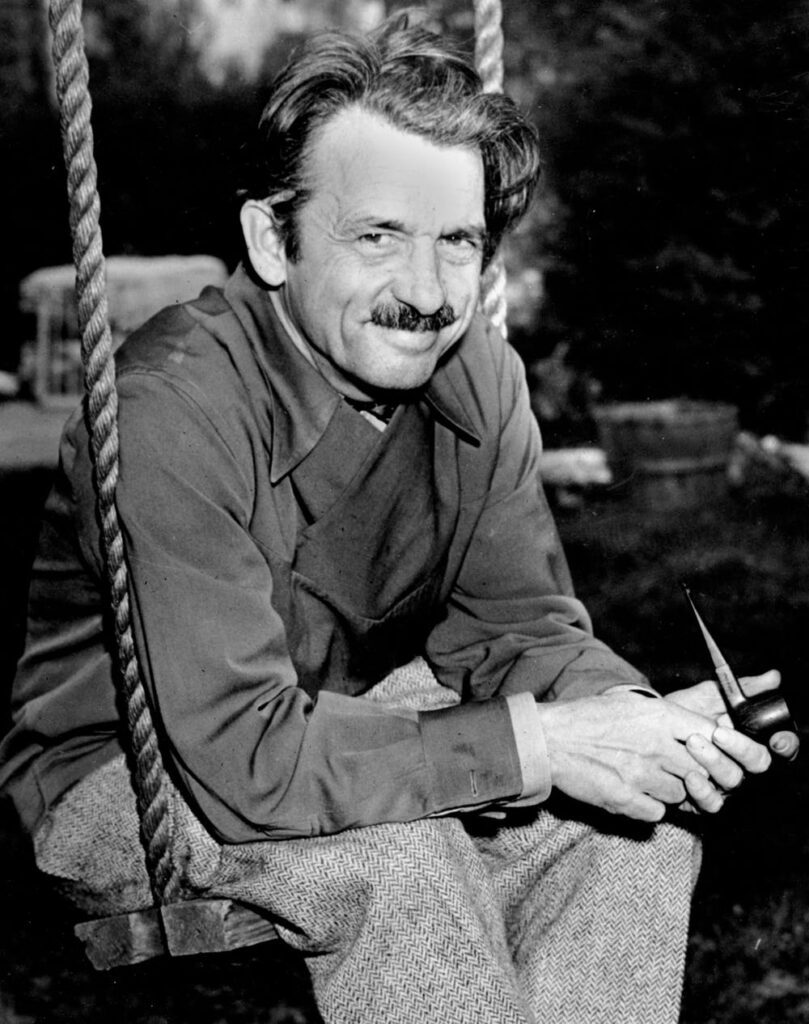
Then you studied with Benton?
Yes, that is right. Under Thomas Benton.
Was this your first formal art training then, the Benton class? I mean more professional kind of training.
I must say I got quite a lot and I got to know him very well was George Luks. I worked with Luks for a winter down at his studio on Twenty-third Street. Again, life class.
Was that a small class?
About twenty I think.
I didn’t know that he had classes like that.
I think he was at the League, too, for awhile.
He was at the League.
I think so. Pretty sure he was.
I think so, yes. But I didn’t know he had private classes.
Well, this was on his own. He had a floor down there and that old building used to be an auction sale building on Twenty-third facing Madison Square Park. It was the Anderson Galleries.
Both the Benton and the Luks were figurative classes. Drawing and painting.
Both were life class mainly in the nude, not altogether.
But it was painting classes?
Painting classes, oh, yes,
Was your first painting done during those classes or did you paint before that?
I guess the first painting in oil.
How did you select the League?
I don’t know. Just went. You see, in those days there weren’t too many teachers around.
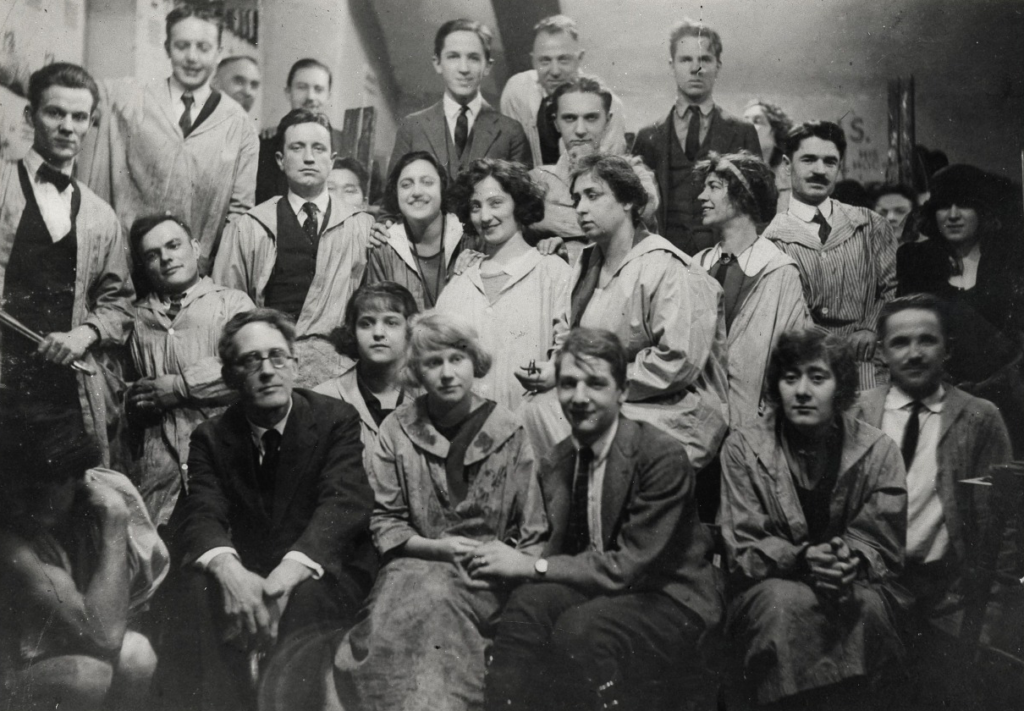
Well, the only trend I suppose was the National Academy or one other school maybe. But it is funny, I had asked one fellow how he went to the National Academy and he said I went to look for the League one day and I couldn’t find it but I knew where the Academy Building was.
Well, I don’t think that was my reason but it might have been because at that time I was living at Fifty-something Street and the League was fairly near you see.
So it was handy.
But that might or might not have been the reason.
Was that the only training that you had?
Yes.
The only real painting classes.
Those two. They weren’t long either. A few months. And then in London I worked for a man called Keith Baines, a very good painter, and in Paris with a man called Pecquereau. And those were the only people I ever worked under in my life.
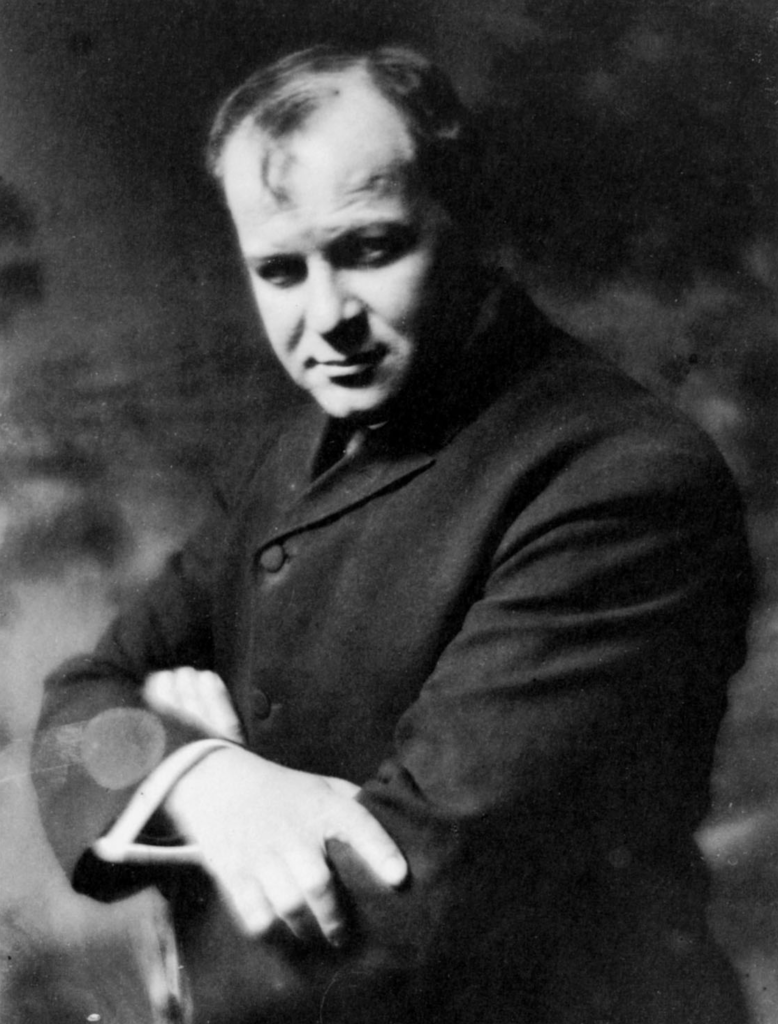
Did you keep up a friendship with Luks or Benton?
Luks, I did. But then he died not so long after that. Benton and I did not, no. I asked Stuart Klonis the other day and he tells me Benton is still alive.
Oh, yes.
I didn’t know that.
Oh, yes. Tough old man. Just about eight or ten months ago he finished a big mural somewhere.
Is that so? Then that is something. But he lives out in the West, doesn’t he?
Yes. Still lives out there.
I never knew him well.
Do you remember anything about the classes?
No. Luks’ classes I remember.
What kind of an atmosphere was it?
Very pleasant.
Do you remember any of the other students there?
Not too well and I must say I can’t think of a single one whose name I ever heard afterwards in the world of painting.
Really? The mortality rate in the art world!
Pretty high.
Yes. What kinds of artists were you interested in then? Do you remember?
Frankly, to answer that question I would say this, that I never latched on to any painters in terms of excitement until I went to Paris and then the whole picture changed.
But this was Paris about when?
In ’29.
So that is really the beginning of the whole career in painting.
Why during those days with George Luks and at the League I never heard the word abstract art mentioned or any examples. Well, it had been going on in Paris for twenty years.
But you know neither Luks nor Benton were really — Benton did abstract painting but he destroyed them all.
Well, he denounced it in no small terms in one of his books.
That book he wrote is pretty wild.
Pretty wild. Now there was some good abstract painting done in America by — Knoedler showed some of it last…
Oh, Stanton Macdonald Wright and Dove and then some of the synchromists. But there were very few. Six or eight people.
That is right. Just that.
You were about in your mid-thirties before you started?
Let’s see. That is right. I was, I was indeed.
How did you get interested in painting? You know, did it just keep going from the drawing and…
That is right, yes.
And carried along right with you.
Yes.
At some point you must have said no architecture.
Well, frankly I never was very happy with the architecture. I thought of going in for interior architecture. That appealed to me up to a point but I didn’t know too much about it. And I thought a training of some sort would be good because that is for anything. But then I realized that I would much rather write than do that, which I did then for ten years.
Well, what decided you to go to Paris at that time?
Well, I tell you I had Paris in my mind or London or both for many, many years. In fact almost from the time I left college. But my uncle was everything to me and I didn’t want to leave him alone, he died in ’28 so the minute things were settled I left. I would have gone ten years earlier if things were…
For the family.
Yes.
You went to Paris first or London?
I went to Paris first and took an apartment there in Montparnasse. It was a very nice apartment and a very fine studio, too. In those days I was writing a book I eventually finished. During that time a friend came to visit me and he wanted to go to London before he sailed back to the U.S.A. And one night we were dining in the flat, there were two French women who went with the flat who didn’t speak any English, and one of them presented a cablegram to me. The cablegram said in effect that the owner of the flat, a Mrs. Hill, was returning to Paris and would like everything in order. Like a fool I had no lease and so that was the end of the flat. I looked at fifty things that I didn’t care much about so he persuaded me to go to London with him, he were in a hotel for a week or so and then he left and I began looking around London and I found a wonderful house. I was there for several years. I’d go back to Paris now and again but I fell in love with London and painted there, too.
Well, did you get involved with the artistic life of these cities?
No. Let me see. I certainly did not in London. Really, no. I loved London and I still do but I left London frankly because while to me it was the most civilized and wonderful place in the world at that time there was no sympathy whatsoever to abstract art.
This was in mid-thirties then.
That’s right it was the mid-thirties.
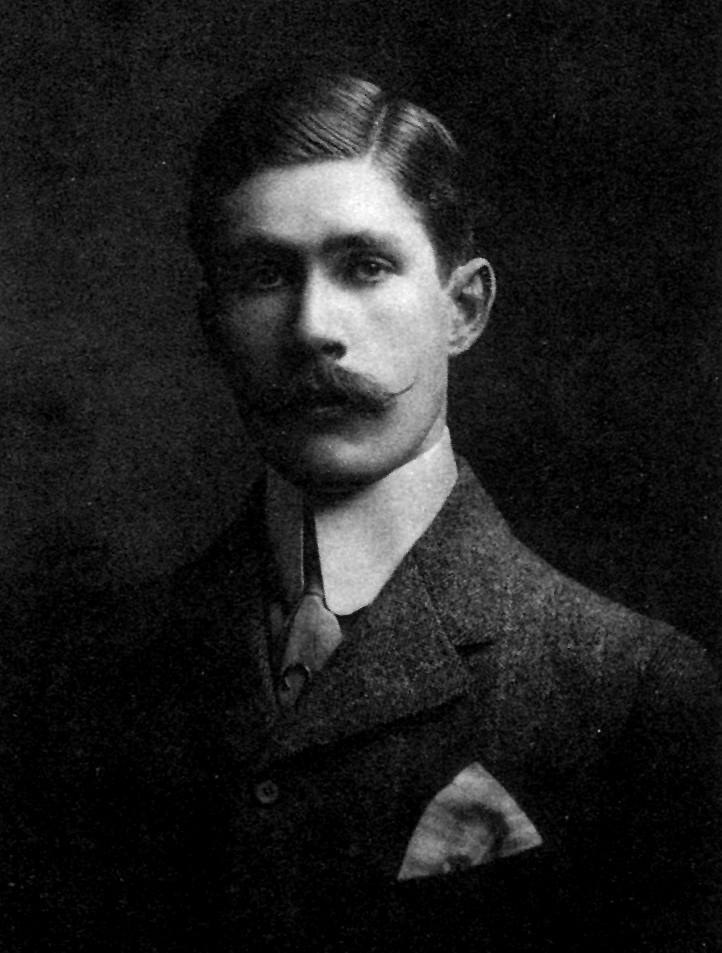
Did you get to know any of the writers then?
I knew some writers, yes. But not painters. You see I was writing there most of the time. I did a little painting with Baines, Keith Baines. Yes, I met Arnold Bennett once or twice and Carl Nicholson and people like that. I would go over to Paris and then when I came back here for good from London — and that was in the later thirties — I would still go over to Paris until the war every year. A man who became very close and a great friend of mine with whom I traveled, too, was Albert Gallatin. he took me to the studios of Picasso and Braque and Leger and so on. He had the finest eye I think of any person I have ever known. Of being able to tell a first rate painting, an abstract painting in particular. He said once to me he didn’t know how he did it. He just felt it.
How did you get to meet him? He is a very interesting fellow.
Yes. And very few people know him at all — he had friends but very few understood. I met him through a very good friend that I’d known before college days who had known Gallatin and we met at lunch at his house one day and we got along from there on. And he gave me a show a few months after that. Down at NYU where he had his collection.
You got interested in abstract painting quite quickly didn’t you?
Well, it would have been a lot earlier if I had been aware of it.
How did it come about after you know Luks and Benton who were really…
It rubbed f on me in Paris. There was none of it around New York.
So it was really Paris that…
No question, no doubt about it.
Opened up everything. Did you get to know any of the abstract painters in Paris at that point?
Yes. I can’t remember whom though. Now that I think, that was after my London experience and it was generally during the summer time.
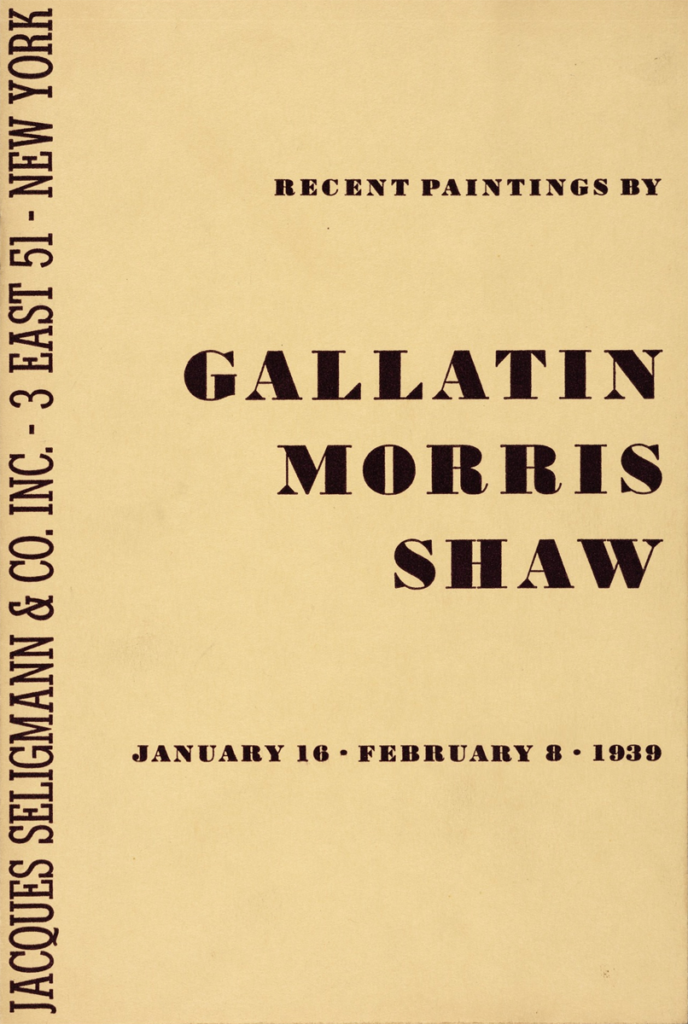
Oh, everybody was gone for the summer.
Everyone was out. And I didn’t do any painting particularly. But I would go back, after I painted here, and I would see the galleries and the museums and all that. I forget who the painters were. At the same time I met George Morris, too. And Gallatin and myself and Morris had several shows together. A couple in London, one or two here.
This was in the thirties?
This was in the thirties.
How did they go over in London? That must have been a little difficult for them, wasn’t it?
It wasn’t very satisfactory. It was at the Mayor Gallery and the criticisms were not good. Stupid criticism. Now that I think of it you know, there was no happy reception to abstract painting in London in the thirties at all. None whatsoever.
Even the surrealists, it was the late thirties by the time they got there.
Yes. Of course, Herbert Read was on the scene there and I think he was sympathetic. He was the only one I guess.
Do you remember the first abstract paintings that interested you?
I would say most definitely Picasso.
Oh, really? Picasso of the cubist forms or later?
Cubist. Oh, definitely the cubist and some late ones too. Definitely cubist and also other artists. Definitely Picasso, Braque, and Juan Gris. These most decidedly interested me at the beginning, and influenced my work, too.
Well, they all still had some figurative elements in their things. Did you have that in your early work?
Well, I doubt figuration, but objects. Objects such as a dais or a table.
I haven’t been able to find photographs or anything of your earlier work.
Well, you know I gave — a gentlemen whose name you told me, now I have forgotten it.
Oh, Avellino…
I gave him a lot of photographs. Lots. But I must say I think they were mainly — some went fairly far back I suppose. They went back I suppose as far as ’38. Maybe not much before that.
Do you keep diaries or sketch books or things like that?
I have sketch books, yes. I have sketch books and I have kept somewhere documents, sketches, loose sketches.
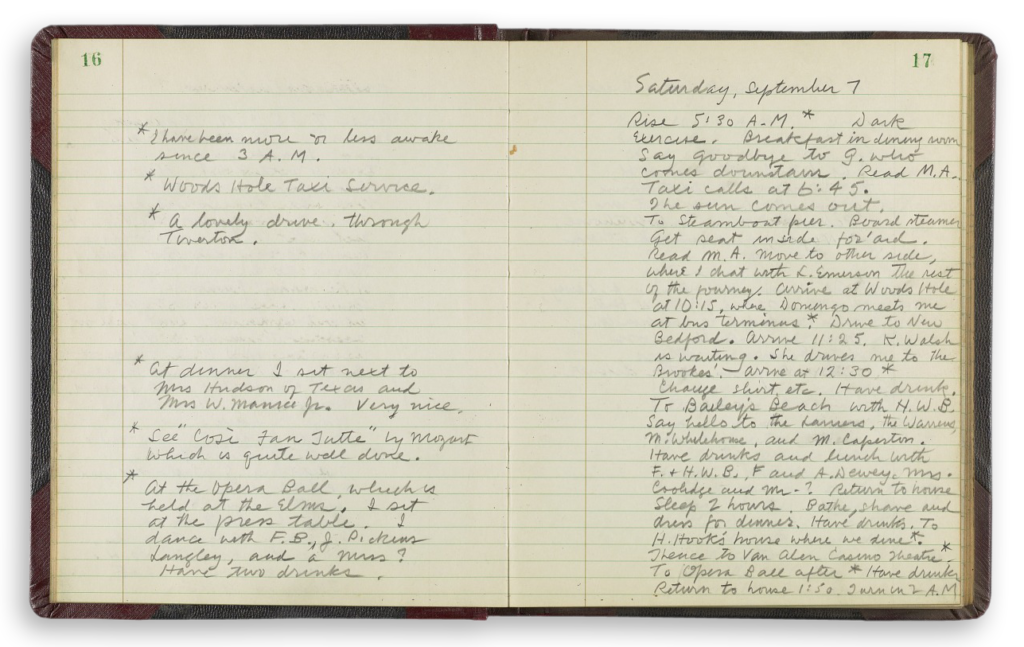
You said when you lived in Paris you didn’t really get to know too many of the art world people.
Let’s see now. I don’t think I did, no. I knew Paris awfully well. I walked over Paris a thousand times, I guess, from end to end. Oh, yes I did, I knew Jean Helion. I knew Helion quite well and also at that time he sent me to a show of John Ferren. He was living in Paris and painting in the abstract. Bill Hayter I knew. There were probably half a dozen, maybe more. They were friends of Mellon and yet Helion at the time seemed to be generally by himself, I think in those days of course the Dome on the Rotund, the cafes would be full of painters. And some of them would talk, talk, talk about the things they were going to do and really painted three pictures a year.
Did you work from a still life in abstract?
Yes, that is right. Abstract still life, yes.
Did you do direct painting or did you do drawings and then the painting?
As I recall it, I think I did most of them from my imagination.
Oh, really?
Yes. I have done still life. I’ve done quite a few still lifes but they were straight still lifes. That was before I went into abstract work. That was when I was in London. But the abstract still lifes I think they were imaginary objects.
But they came after the other ones?
They came after the other ones.
So in a sense you had built up a…
That is right.
A vocabulary, here there things at Yale or Columbia that interested you in the educational experience?
Well, I had a very good time at Yale and I was a pretty good scholar I suppose. Nothing extraordinary.
You were active on the one publication?
On the Record, yes. Oh, I think I did some drawing for one or two of the other publications, too. One was a literary one but I can’t remember the name of it and it’s still going.
Were you active in any other student activities?
Oh, I played games, that is all. No, I frankly wasn’t. And at Columbia Architecture outside of the classroom I didn’t spend much time on Morningside Heights.
You just went to class arid left. Did you go to museums when you were living in New York or see the collection at Yale?
Not when I was a graduate, no. As a matter of fact in those days, you know there must have been a Yale Gallery of Arts but I can’t recall it at all. I think it was awfully small.
But you didn’t go to the Metropolitan in New York?
I did go to the museums abroad a good deal though. The Louvre and the National Gallery in London.
Well, you have traveled elsewhere than England and France.
All over Europe. All over Italy, Spain, Morocco, Germany, Switzerland. With Gallatin once we took a trip from Paris up to Holland and Norway, Sweden and Helsinki, Finland.
How did you like the Scandinavians?
Very nice. And Gallatin had his eye always open for museums — they did a lot of museum work. But then again there was nothing at that time that was at all abstract or non-objective in those countries.
They were terribly figurative.
Absolutely.
People with hats on.
I believe now they are getting around to it.
And they are showing great interest in other people who are not figurative.
But Switzerland, of course, the Gallatin family was originally Swiss. And the Swiss were marvelous collectors of abstract work.
Oh, really?
Oh, yes. Even far back.
Oh, I didn’t know that.
There were people who had superb collections of Picasso, Braque and everybody. That was in the thirties.
That is interesting. So then there were other people in his family besides him that collected?
No, I would say they weren’t in his family, heavens knows. They were Swiss.
Oh, I see. The other side of it. Well, the Swiss have always built interesting collections that no one ever knows about. They are very secretive.
They are probably all over the place, too, you know. You see, you don’t know about it at all. I heard it not so long ago of a collection of Rosenthal porcelains that made the museums’ look like nothing at all.
Very quietly accumulating everything. Well, how did you like traveling with Gallatin? You seem to have spent quite a bit of time with him.
Well, off and on. He was a very companionable fellow. Other people had a hard time of it, I think, but we clicked all right. That was the only tour I ever made with him but I’d see him often enough when we were together in Paris or in London, or in New York.
How would you describe your wring activities? Was that just something that developed or was it a need, a way of expression?
It was a way of expression, yes.
Because writing for that length of time and publishing that much is a full time career it seems.
Yes. In those ten years I did nothing else. The painting came toward the end of it but that didn’t interfere with it at all. Oh, another publication I wrote for in those days, I wrote quite a lot for, was the original Life.
Oh, the humorous one.
Yes, and I got to know the editor of that very well and a very nice man he was called Louis Shipman who was an author and a playwright.
I’m trying to pull out more of these people because they are in so many worlds, you know — the writing and the painting. Were you ever active in politics?
I avoided politics as the plague all my life. I still do.
No interest, no…
Well, it is hard not to have a certain interest but as little as possible. And the world of finance is another I avoided. It is boring to me frankly.
Sitting there talking about money all the time.
Money, money, money, money. And I have known so many people, and that goes for some good friends of mine, who were cleaned out completely. Completely. If they had done anything it would have been better than that. Stayed in bed.
Are there any other family associations that were important to you?
No, there really weren’t.
Very singular kind of existence then wasn’t it? Have you continued reading?
I read quite a bit of what I believe has been called “escape’ but which I rather enjoy if it is good writing. There are a few good writers that do mystery stories.
Like who for example is your favorite?
Well, I can give you two or three. One is a man who writes under the name of Michael Innes. His right name is Stewart, J. I. M. Stewart. Another is a man who was made Poet Lureate of England the other day. Writes under the names of Nicholas Blake. His right name is Cecil Day Lewis.
Oh, really?
He is very good. He was writing mystery things up to a year ago and maybe he still does, and very good ones, too.
You like the English writers?
Oh, yes. Much better frankly.
Do you like Fleming?
Fleming is more the — what do you call it fellows,..
James Bond.
James Bond more. I get awfully tired of the spy thing.
Oh, really? They’re very contrived.
Very contrived. I would have liked him at the age of fifteen but not today, But a lot of them are good — not a lot. They are not a lot of good anything.
That is true.
There are a few pretty good, more than pretty good writers of that sort of a…
Do you prefer the English over the American writers then?
I do. I do, Maybe I haven’t examined the American ones sufficiently. There are one or two fellows that write — you would almost think that they are English because they know the subject so well that do that and one is a fellow called — he had two names again. Carter Dickson is the nom de guerre, I think. And his correct name is something like Dickson Carr. He’s quite good, too, and very prolific.
Did you ever read Mathew Head’s books, or don’t you know him?
I don’t know him.
That is John Canaday’s other name. He writes fiction.
Oh, really? Is that right?
And detective stories under that name.
Are they pretty good?
I haven’t read any.
I’ll try them. Head?
Yes…
Nope. I don’t know the name.
What other kinds of things do you read? I’m surrounded by books here.
Well, I re-read a great deal too. Bernard Shaw, Wilde occasionally, George Moore, G. K. Chesterton. Of more recent years I can’t think off-hand. I have read a great deal, as I was saying before, on psychic phenomena, too.
Yes. When did that start?
I don’t read so much now because I can’t find anything that’s any good. That started about ten years ago or maybe fifteen. And I read the works of the giants, they don’t exist anymore because they died. F. W. H. Myers, Podmore, Mrs. Sidgwick, they were all the heads of the Society of Psychic Research in London. They were terrific. And they would accept awful little. But they accepted quite a few things that most people would simply say that you are talking madness.
Did you ever visit the Institute in London?
No. You see the one reason I didn’t is because I haven’t been back for so long. It would be one of the first places I would go to the next time I go.
There are a couple of great occult bookstores in London that are incredible.
There is only one in all New York that I can think of.
The Weiser.
That is right. The only one in all New York, today, I think.
Well, there is one on Lexington Avenue.
Upstairs. Is that any good?
So-so.
The Gateway wasn’t too bad but she died. She was on Sixtieth Street off Madison.
Old Weiser has everything. Incredible place.
Very few people know about him that ought to I mean.
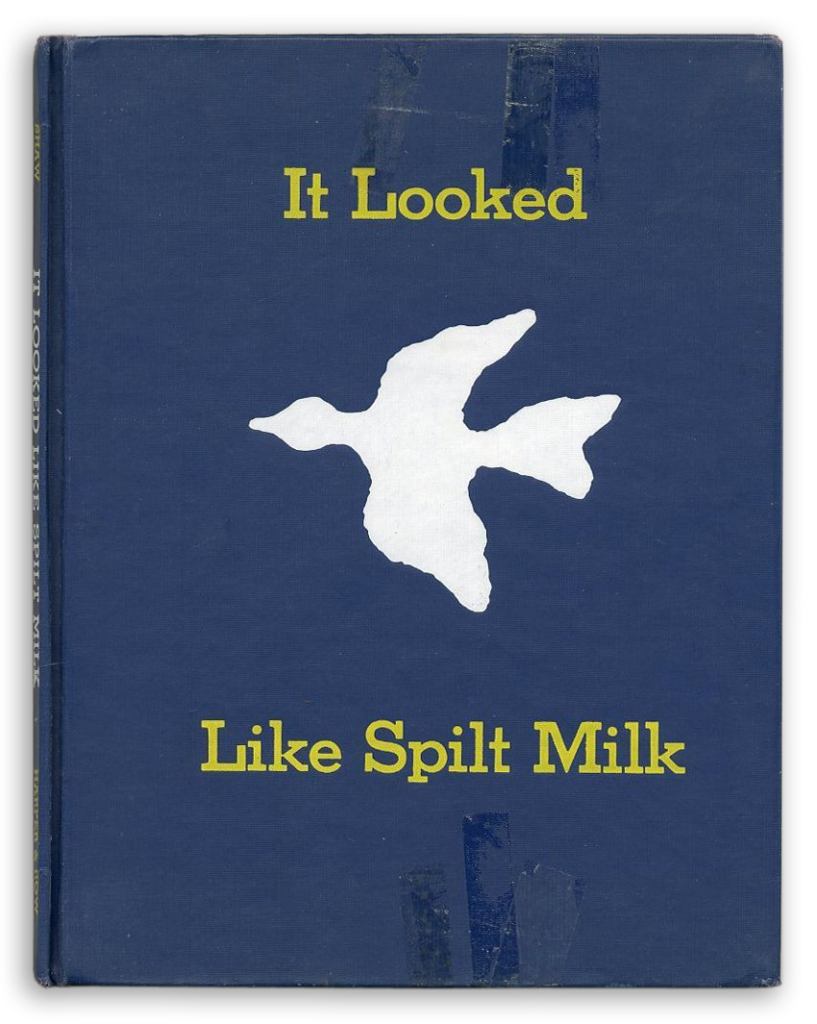
Oh, yes. It is all strange, you know, how difficult it is for books to get known and book sellers to get themselves known like that.
Another source of revenue I found very interesting and quite remunerative was children’s books. From about 1938 to ’48 I wrote a great many and published a great many. One book I had published in ’47 I get royalties on every year. Twenty years.
That is pretty good!
I consider that book a best seller.
Absolutely.
Published by Harper and Row.
How many books did you publish if you count the children’s books?
I suppose about twenty counting the children’s books.
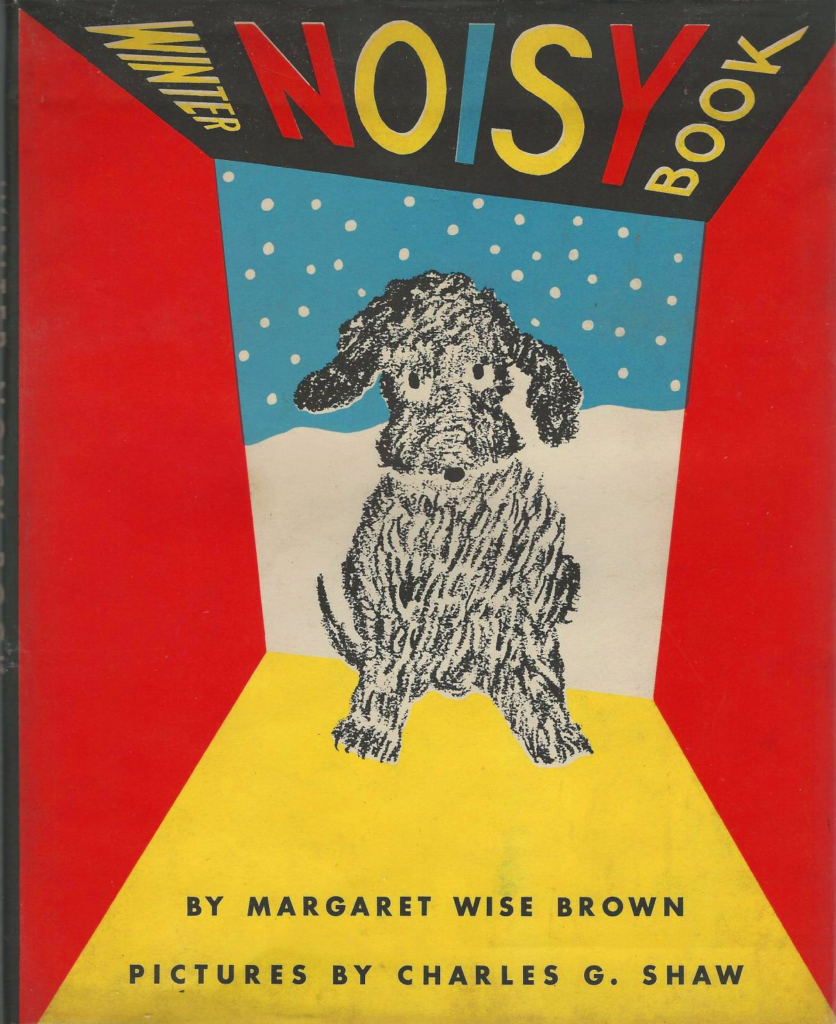
How did you get started writing children’s books?
Well, again I thought it was a good idea. And I must say one person who gave me a leg up, as they say in England, who became a wonderful friend and heavens she wrote children’s books on the back of an envelope going out to dinner and they were published. Her name is Margaret Wise Brown, She must have written fifty and a lot of them sold wonderfully, too. She had several publishers but one of them was W. R. Scott who is still going and specializing I think in children’s books and they published the first two or three of mine. Maybe three or four, maybe more and then Harper published the others.
Well, how did you find that as a writing experience after having written all magazine pieces?
Well, that was mainly illustration, you see. The writing part was not so hot.
Oh, I see. They were really sties told by pictures.
More or less, yes. The first one as a matter of fact, which didn’t go too well although Grosset and Dunlap bought it afterwards from Scott, was called “The Giant of Central Park.” And that had quite a story to it and that was the only one that had a real story and pictures both. The others were mainly pictures with just a line underneath the pictures.
Well, they must have been rather enjoyable to do.
Yes, they were. And most of them were in color. In fact all were in color except the first one. That was black and white.
Well, that is interesting because these are obviously figurative illustrations and things like that. How did that go with the abstract painting?
Well, it was really a thing apart, it didn’t confuse the other at all. In one of the books I did have a completely abstract painting in it.
Oh, really?
And somebody told me recently that there was such a thing as a children’s book, an abstract children’s book. I have never heard of that. I think I would have but I think it is quite new. Just very recently I heard that.
I will have to check. I have a friend who is a children’s book editor at Doubleday.
I would be very interested.
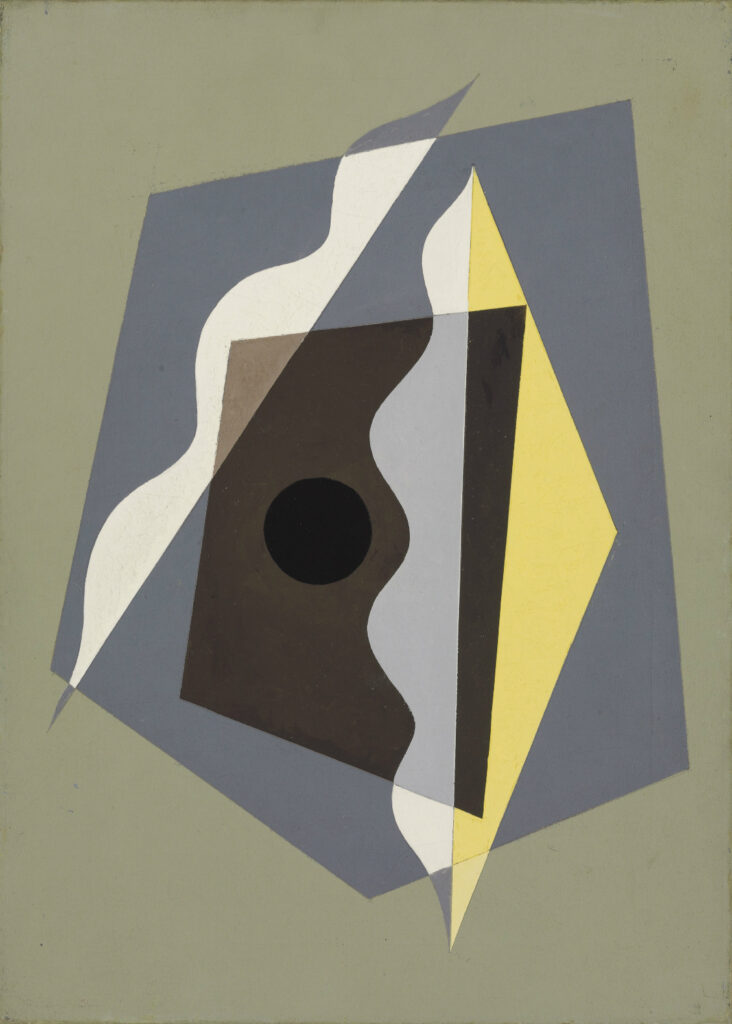
Well, you came back to New York then about 1939, 1940?
I moved into this apartment the same day that Hitler moved into Poland. I can remember it very well. My stay was longer than Hitler’s.
Your first show in New York was at Valentine’s, 1934?
The Valentine Gallery, 1934, and then my next one, I think was in ’38 at the same gallery.
And those were abstract paintings at that time?
The first show was semi-abstract and the second was pure abstract.
The first was still under the cubist influence?
That is right. Definitely under the cubist influence.
And the Gallatin show was in ’35?
That was in ’35 and that was some cubist influence. I can’t seem to remember many of those paintings. I think Gallatin gave me two shows downtown. I am not sure. One was in ’35, I think he gave me two but I may be wrong. I think there was another around ’38.
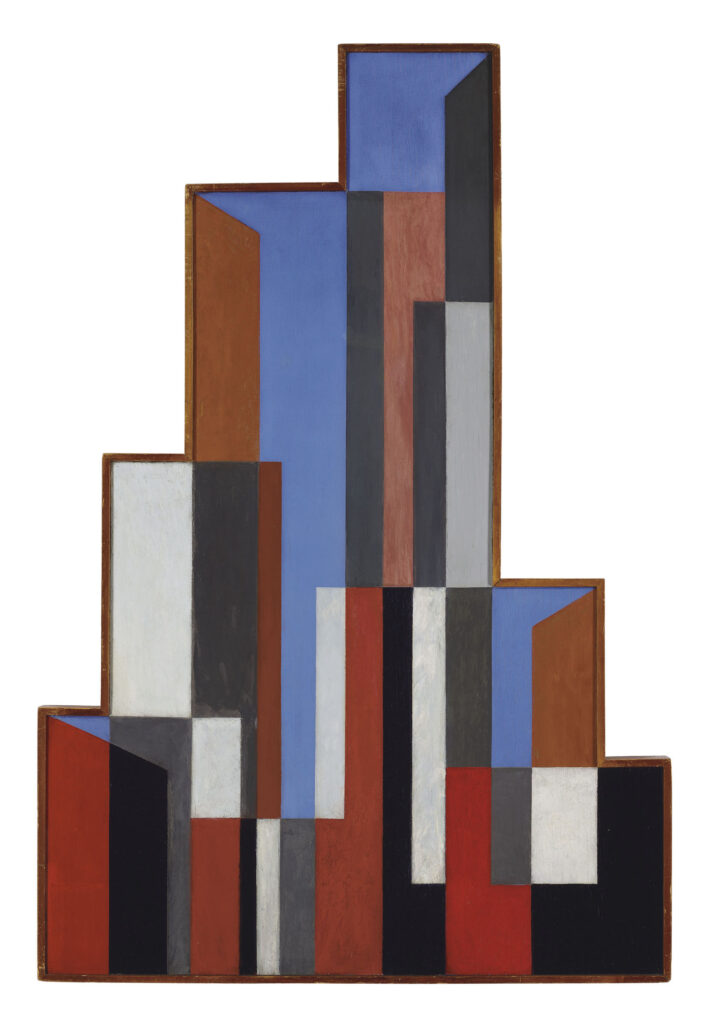
There is a Guggenheim in ’40.
There were two shows there when the Baroness Rebay was running the show. At that time it was called the Museum of the Art of Tomorrow. It had two names. One was the Museum of the Art of Tomorrow, and Non-objective.
Yes, the Museum of Non-objective Art was one at one point.
That’s right. Yes, in ’40 and ’41.
Was that a big show?
No.
They didn’t have a large space then did they?
It is all broken up so strangely. There weren’t more than a dozen paintings. I haven’t really shown with many galleries. Besides Valentine, Dudensing, I showed one year at the British-American on West Fifty-fifth Street. The other two galleries were the Georgette Passedoit Gallery and Bertha Schaefer over a period of ten years.
Al Landry.
Oh, Landry. That’s right.
Two shows with him. He had worked with Passedoit, hadn’t he?
He and Passedoit were together for those years. And then she retired completely and he went off on his own for a year or so and then he went to Detroit and then he came back here for a while. But not to the gallery.
Well he was at Marlborough but no more I guess.
No more. But no gallery of his own I mean.
What did Passedoit do, do you know what happened to her?
Yes, I spoke to her on the telephone yesterday.
She is here though in New York?
She has come back. She was in Paris for three or four years and she has been here for about, I think, six or seven months.
In the late thirties and the forties did you get involved with the WPA Projects or anything like that?
No. I knew all about them but I never got involved.
Well you were writing and you had varied sources of income I suppose.
Yes. And also Dudensing sold quite a few of my paintings, too.
Oh, really? I know you are in many public collections.
Yes. I’m in over 50 I think. More, I think.
Well, that is interesting. So he was selling your paintings in the late thirties?
Yes.
That is pretty good because there weren’t many abstract painters who were selling.
That is true.
Bolotowski had a show with him at one point.
Oh, did he? I didn’t know that.
I think it was Valentine and he said it was very nice but not a lot of actual sales.
I can tell you a story which to me is one of the saddest commentaries on such things I have ever known and I knew it and that was the Seligman Gallery. And it was a very nice gallery on Fifty-first between Fifth and Madison. And the year was ’38, and I had a show there with Gallatin and Morris. Now either it was before us or after us, I don’t know, but there was a show by a man called Juan Gris and there wasn’t a single painting sold. And I don’t think there was a single painting over a $1000 in 1938. Now you know what Gris brings if you can find one.
Yes, if you can find one. It is amazing.
Amazing.
It is just incredible. I mean you look at art at the point of the market it is unbelievable.
All in thirty years.
You had quite a number of shows at Passedoit?
Yes, about ten, I think.
Almost every year for a while. What kind of a gallery was that?
Very nice. An intimate gallery, it was small. And it was very correct. No nonsense about that gallery and she had good people. I don’t think any brought fabulous prices but nothing did in those days.
You seemed to have developed a following quite rapidly.
Well, in a way, but to be realistic and factual about it there were certain years in between there where the sales were few and far between. I would say particularly between 1945 and 1952 it was pretty slow.
There was the rise of abstract expressionism in those days.
Yes, I guess that would be, because I remember from about ’53 or ’54 until she retired I did awfully well there at the Passedoit Gallery.
I remember visiting that gallery a few times. She was on Fifty-seventh Street a long time wasn’t she?
She was always on — well, practically always. Ever since I was with her she was at 121 E. 57th.
Right. You were saying before that writing and painting were tendencies to communicate.
I would say the writing more than the painting frankly. The painting I thought was something I wanted to project not so much in communication save an aesthetic one, yes. But the writing one was different. I think in both those vehicles one of the major issues I had in mind was form. The form of the thing, whether it was a poem or a piece of prose or a piece of painting.
In the writing then you must’ve been very interested in certain styles?
That is right, yes.
Did you do any murals ever?
I don’t think I ever had a mural in mind really, no. I have done a few posters. I did one poster I hadn’t thought of for twenty years until the other day.
What was that one done for, the War?
No, this was done for the Shell-Mex Company in London and I did it in the hotel room and they took it and it went all over England and Clive Bell gave it a good word. The theme of the show was “so and so” use Shell. Mine was “smokers use Shell” with the big pipe and there were other tobacco items in it. It was quite a big one. And I have done a few magazine covers.
What were they for?
Vanity Fair. I have one I got yesterday of a poetry magazine, abstract cover.
Do you still publish poetry?
I published over 200 poems last year.
You must put in a pretty good day, don’t you?
I put in maybe too much.
I want to go back here to the late thirties. Are you a member of the American Abstract Artists?
Yes. I have been a charter member since ’36. That was our first show.
How did you get involved with that group?
I think I got involved through George Morris. How he got involved I don’t quite know. We have meetings downtown at various of the members lofts or dwellings or studios.
You exhibited with them all the time.
Exhibited for thirty years.
Have you ever been active on any of their committees?
Yes, I used to be. Not recently. In the beginning I found quite a few places for the shows.
You mean places for the exhibitions?
Yes.
Did you have any particular attitude about that group?
No. No. We worked in harmony pretty much and then I suppose after about ten years, which was quite natural, people dropped out and new blood came in.
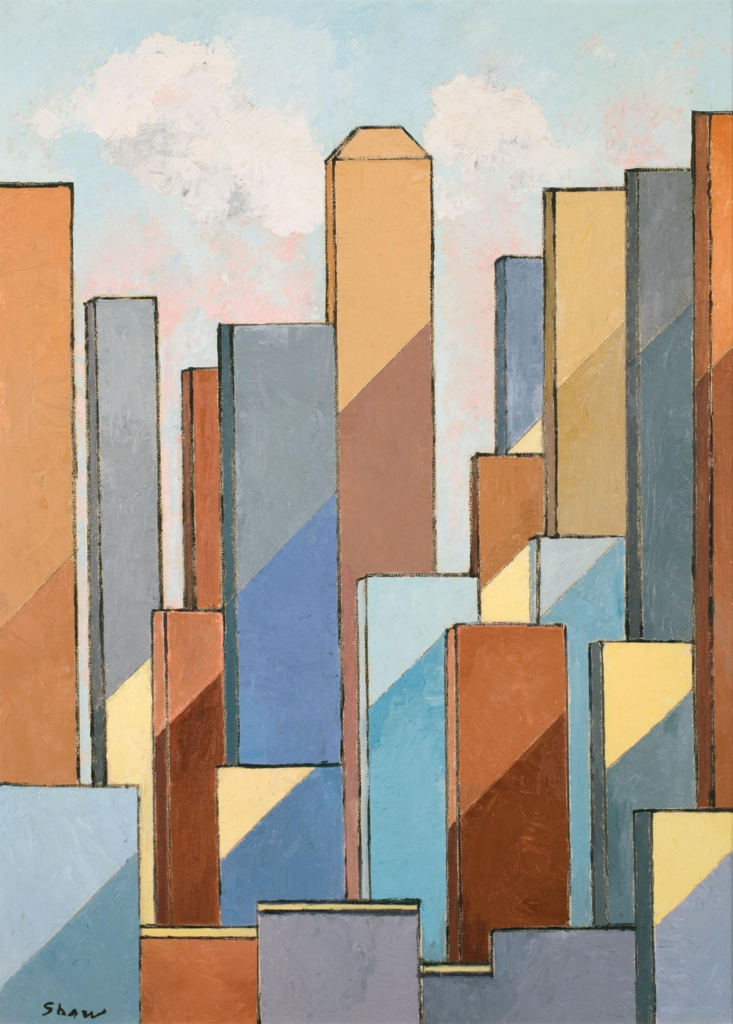
Well, Mondrian and Leger were members of that, weren’t they?
They were. That is right.
Did you get to know them when they were here? Or had you known them in Europe?
I had met Leger in Europe. I got to know him not terribly well. Not terribly well, but I got to know him, yes. It seems to me there was somebody else too. No, I guess not.
Then you also had the Federation of Modern Painters.
Yes.
They were formed a little later or about the same time?
A few years later, I think. I can’t pin it down. I would say three or four years later, about 1940.
And you just exhibited with them?
I have exhibited with them ever since, too. Annually.
What is the International Institute of Arts and Letters?
That is something that I can’t say much about except that it is on Lake Constance and we get a certain amount of literature every so often, most of which is in German.
Do you know what their function is or what they do?
Allegedly a literary and aesthetic one. I don’t think they do much about showing but they do occasionally, I think, too. I haven’t heard any now for quite a little while. Over a year or more.
I have heard vaguely about them but I didn’t know what [they] were about or who their members were.
Well, I have a list of the members, too. The vast majority of the members are not American which is quite understandable.
I have a note here that you are a member of the Century Association.
Yes. I have been a member of the Century for about ten years I think. And the Century Association has always been very coy in the matter of publicity. But this is not publicity. Last year I was really delighted by two things. One was I got first prize for a painting in oil and, two, they gave me a one-man show.
Oh, that is interesting.
And I was very pleased by it. It went off very well.
They do very nice shows there.
Yes, they do.
Modern, new, everything, they are quite nicely done.
That is right.
Is that a large club? Do you know?
Do you mean physically?
Yes.
It is fairly large I would say, yes. I have never seen it crowded. It is a lovely old building. It was built by Stanford White and the room which is the art gallery to me is superb. To me it is as fine as any room in New York. It has a sky light which is most effective. And it is a good size. I had 32 pictures in my show and most of them were big pictures.
Were they recent things or a survey.
They were all within the last six years.
That is nice. Most of their members are what, literary or art people?
Most of them are literary or publishers, quite a lot of lawyers. They have changed in the last few years a good deal. The old days, I believe long before I was a member, they were almost exclusively writers or painters. Now they are publishers, lawyers, a few clergymen, doctors. Professional people. And in the last few years they have injected quite a lot of new blood.
Are you active in any other groups or associations?
No. No, I am not at all anymore.
Have you been?
Well, for awhile I was with the Nantucket Art Association but that was years ago, although I go there still. But I generally have a show at a friend’s house. I don’t show at the Association. I judged a show last summer at the Association. I have been spending my summers there for twenty years now.
Oh, really? It is very nice there.
It is. It is a very nice spot.
How did you pick a place like that?
Well, that is a very good question. I am afraid one of the reasons was that so far as I know it’s one of the few places in America, the only one I can think of though I don’t say they don’t exist, where a car is unnecessary. It is very nice to have one but I get along quite well without one.
The Hamptons and Woodstock and places like that you really need transportation.
I love walking but outside of my walking there are buses to the places I would go. But a car can be awfully nice there if you want to make a tour of the island or go bathing on the other part of the island.
Do you paint there?
I paint up there, yes.
You paint here, too, or do you work one place more than the other?
Well, I work more here I suppose. One of the reasons being that there, I have done quite a lot of oil painting there, but the last year or two I have confined myself to brush and tempra, watercolor work for documents for big paintings to work on when I get back.
Oh, I see.
Recently for the work I do I am at to make sketches beforehand for a variety of reasons, the major ones being it will save an awful lot of paint and a lot of time, too.
To work it out in a small version and then…
And then blow it up dimensionally to scale.
You work it out with color and everything.
Everything.
It is like a miniature version.
That is right.
You were in a group in exhibition one time called the Concretionists.
I remember giving it that name. I remember coining the word and I think that was the very first time that Gallatin appeared on the scene with George Morris and myself. But I can’t remember who the other people were besides Morris, Gallatin and myself and possibly Suzy Morris. I don’t think there was anybody else in it.
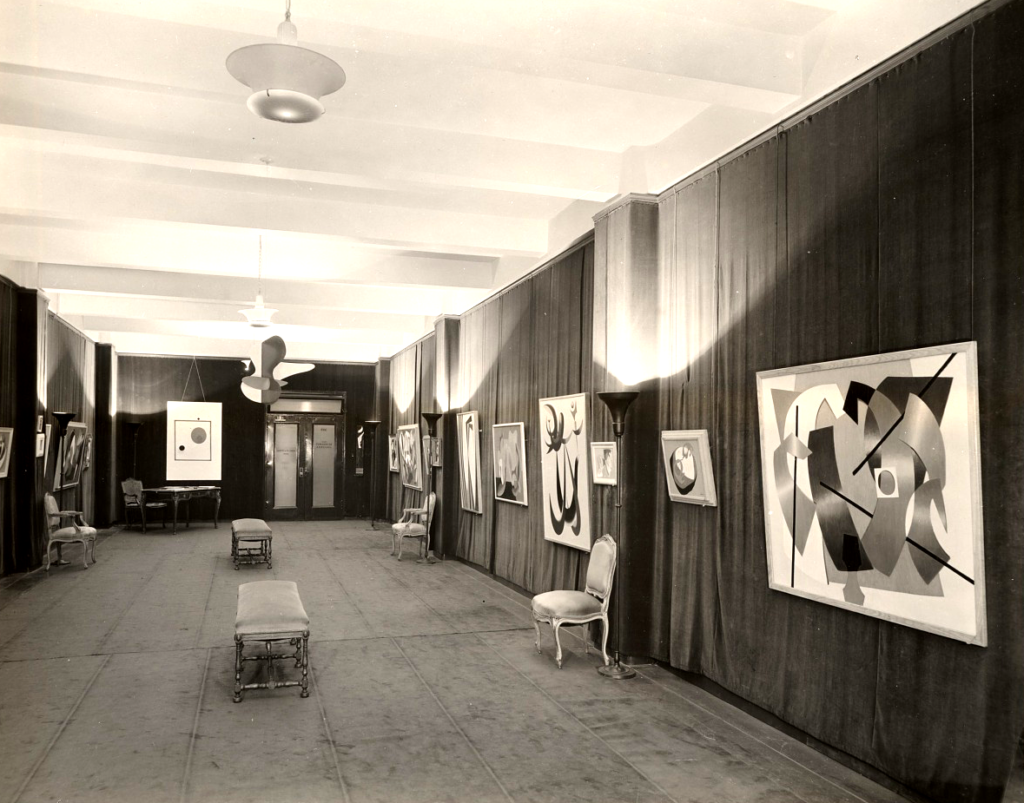
Where was it?
I think it was the Reinhardt Gallery, but I may be all wrong about that. I know that we had a show there but I don’t know if that name applied to that show, but I think it did and it would have been about ’36 or so.
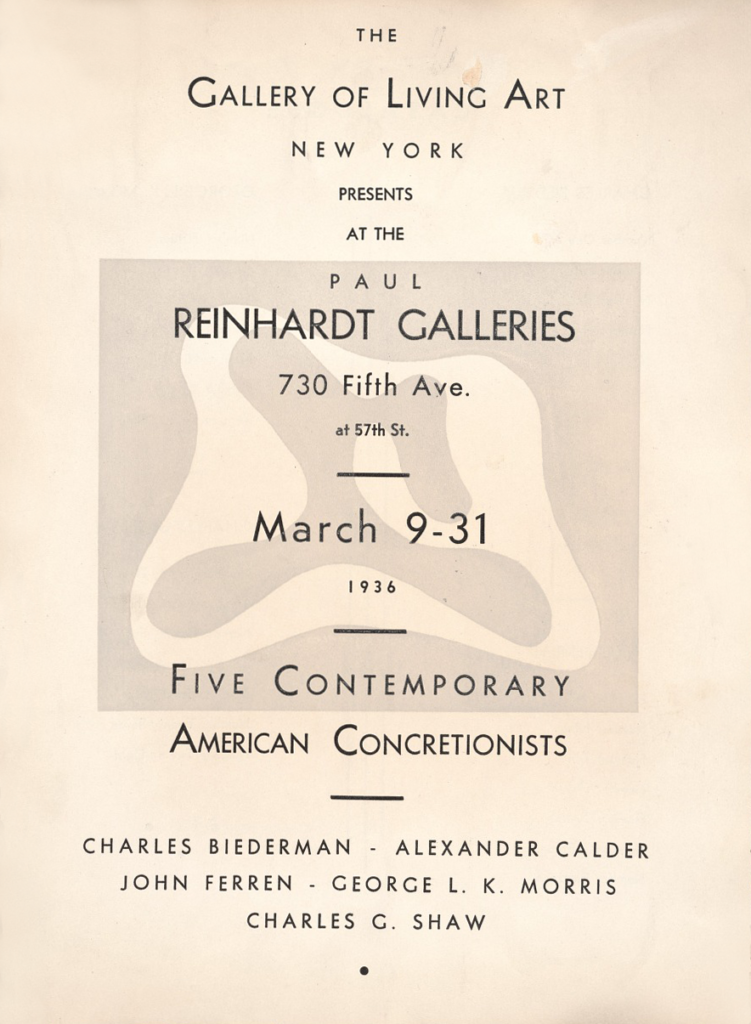
What does the word stand for?
As you doubtless know the word “abstract,” even to some people today who ought to know better, use it entirely wrong, applied to the field of painting. They think of it as an abstract idea. The word should have been extract and that is why I wanted to make it more to the point and call it concrete. The concrete objects. They could be abstracted true enough but they were concrete and not the idea of an abstract in law.
Well, most of them were non-figurative paintings, weren’t they? I mean non-objective paintings.
That is right. That is true. I think they all were.
Over the years, in the thirties or the forties, were there any artists who interested you particularly?
Yes, I am sure there must have been. I always try not to get influenced though. I thought Franz Kline was very good.
Did you know him ever?
I never knew him, no.
Do you associate with many artists now?
Well, off and on, now and again, then I won’t see them for a long, long time.
Then it is just sort of chance?
More or less. Not entirely but I am afraid chance plays a pretty big part in it.
Is there anyone or any discovery that in some way has helped you toward the realization of what happens in your painting?
To be quite honest I can’t say there is, no.
It is really your own.
I would say so.
Batting away, working away.
I think so, yes.
Do you feel there is any interchange between the writing and the painting?
No, I don’t, I really don’t. Two entirely different aspects.
Different facets.
I think so. I have often thought of that but I can’t seem to connect them. Unconsciously maybe, at times. I got a very nice review of my last book of poems this morning from an English magazine and the point was stressed there that they could see that I was a painter. I wouldn’t myself be aware of it.
Have you ever gotten interested in any of the theories of neoplastic painting or non-objective art? You know, like Mondrian wrote a number of essays and…
Yes, I have read them all.
You wrote one I think.
I wrote one for the first book we brought out for the AAA.
Have you written any others subsequent to that?
I think I wrote a little one for a magazine called Plastique. It is called Plastic or Plastique, both. It didn’t live very long. I have no idea what the thing was about now. Quite honestly I feel this. Now and again I write a little statement, and one of the observations I made in one of the statements was that I can’t help feeling that I agree with the words of Goethe who said artists don’t talk they paint. Because I have known so many people who could talk beautifully but they never did much about painting. They worked it all off in words.
I am particularly curious because you do write.
Well here is another curious thing. I have known a good many writers and I think writers seem, as a rule, awfully far apart from painters. I don’t include critics there. And worse than writers, and why I have often wondered, are musical people. I have known a few musical people and they weren’t interested or when they were it was always in the wrong thing. Why I can’t imagine.
Well, I suppose it is an auditory orientation towards things and they just never think of looking at anything.
That may well be it. That may be the answer. Well, I find that the case. Years ago particularly. And writers also by and large.
Well, I know theatre people and when they start collecting paintings it is generally quite extraordinary what they end up with.
Well, I used to know quite a lot of theatre people none of whom were in the least interested in art. And certainly I have never known a theatre person who gave a damn about abstract art. Because I think they are interested more or less not in really the art but in the subject matter, or the story it would tell or some connotation of that sort.
Oh, yes. Well, one of my friends who is in the theatre and collects says really every actor sees himself as Hamlet in this painting. You know, they are going through the motions or whatever the activity of the painting. If it is abstract, non-figurative, neoplastic they find it very difficult to be patterns of color and lines and things.
But then I have known other people, who couldn’t be nicer, too — they practically dislocate their necks by trying to bend them so that they could recognize something in a non-objective picture.
They have to find an image.
Which wasn’t there.
It is a big, American thing, don’t you think? You know, to paint what you see.
I always think of Whistler’s line: I paint what I see and he said but do you see what you paint.
He was a great verbal fencer.
James the butterfly.
Yes. Extraordinary. How would you evaluate the art studying you had with Benton and Luks? Did you find that that was really helpful?
I suppose it was, yes. Frankly I don’t think it helps me with abstract painting at all. I suppose anything you do really in the way of painting with a brush in your hand is helpful at a certain period of your career particularly in the beginning.
Some professional assistance or criticism.
I think frankly I learned most from the few people I worked with was from this man Pecquereau in Paris.
Who is he? I don’t know that name.
He is not known I don’t think. A sculptor friend of mine in Paris put me on to him. And I think I learned more from him than all the rest of them.
What do you mean? Just about painting or materials…
About color.
I have seen the recent paintings but the early ones I don’t know.
Well, I will very gladly take you into the room there and show you some early ones.
Okay. Well, have you done, you know, experiments — we will talk about color maybe a little bit later then — but have you done any experiments with new materials or anything like that?
Oh I experiment all the time. I’ve done collages way, way back almost as far back as Schwitters I guess.
Oh, really?
Yes, A lot of it I have shown. Not papier collage necessarily, I have done a lot of them, but also with materials. with skins and things, cloth. All kinds of stuff.
When did you start that?
I think I was showing them to a museum person not so long ago and he was very amazed and said he never knew all this. I think I had done them for ten, fifteen years. Fifteen years, yes. Then I have done some wooden objects too.
In construction?
Assemblies. I would do a lot more frankly if I had space. You see, you need space for that. You need space for everything really. It fills up in no time if you are fairly prolific. They gang up on you. I have struck an awful lot paintings, a terrific amount.
Well, let’s talk a little more about the writing first and then we will go back to the painting.
Right.
The writing career you said really started after the first World War, about 1920.
Well, I did a little writing before we went into the war, in ’16 after I left Columbia. In fact I began then I guess, but I can’t remember what I wrote for particularly until after the war,
You just mentioned a minute ago that you had written a piece for the New Yorker.
I wrote quite a lot for the New Yorker from the beginning, from its first number.
Oh, really?
Yes. I wrote pretty regularly until 1930 when I went abroad.
What kind of pieces did you write for them?
Various kinds. One was sort of a column that ran every other week or every week having to do with how well Do You Know New York.
Oh, really?
Things in and around New York. Questionnaire sort of.
Like the parks and the zoos and the buildings?
Restaurants and strange out-of-the-way things.
Antique stores and book shops.
And then I wrote a number of articles on how I feel about things in general. That type of article.
Well, what were they about? Just your own ideas about what was going on?
Everything, everything.
You would sit down and say well, I will write about auctions today.
Well, no, it wasn’t that specific. It was, for instance in a simple sentence I might list a dozen things. And then I wrote several, mine weren’t called profiles but they were that idea. They were always shorter. Three or four or five eventually came into the book that I did in ’28 called The Lowdown. Some appeared in the New Yorker originally.
Biographical sketches.
Biographical sketches.
Well, that was fun. Were they all research projects or did you interview the people?
Oh, they were all interviewed and in the book there were twenty-eight people, men and women both. Very few are on the scene today.
Were they friends of yours or were they celebrities?
They were all pretty well known people and I think that I knew about two thirds of them beforehand.
Were you assigned to these by the magazine?
No, I did them on my own. In fact I began it before the New Yorker thing began.
Why weren’t they published before then?
I didn’t send them to a publisher at all until the book.
Oh, I see.
Some were in Vanity Fair, the New Yorker and the Bookman.
You must have known all the magazine people then.
I knew them pretty well.
Did you know Thurber?
I just met Thurber. I never knew him very well but I admired his work very much. But I knew George Nathan, Mencken.
How about Ross? You must have known Ross at the New Yorker.
Yes, Ross.
Did you Know Ross very well?
Not terribly well but I knew him for a period of years, yes. I think I knew Ross before he came to the New Yorker. He was on Judge.
Oh, yes.
The old Judge.
Right. Well, who was your editor then? Who did you work with at the magazine? Do you remember?
I think Mrs. Ingersole. I am pretty sure. But I generally sent the things in. I would drop in occasionally. I know Mrs. Ingersole was there for a long time, And at Vanity Fair, he who became one of my very best friends, he was younger than I, was Donald Freeman. He was Managing Editor. Donald died in ’32,
Well, you must have great circles of friends in the literary world and the art world as well.
That is right. And a good many worlds.
That’s fun. It makes things more exciting.
Yes, and I knew all the people in show business, too, in those days.
You had mentioned that you had [written] a musical? You were involved with a musical?
I did the lyrics and half the book, the libretto called “What Next” and it ran at the Princess Theatre for three weeks. That was all it was supposed to run. And Deems Taylor wrote the score.
Who was in the production, do you remember?
Well, it was semi-amateur, semi-professional.
How about Deems Taylor, you must have known him somewhere along the line?
Oh, yes, absolutely and a very nice man he was, too. Yes, I saw quite a bit of Deems.
Did you know other people in the music world?
Yes, I knew Cole Porter very well. I knew George Gershwin fairly well.
You didn’t ever do projects with them.
No. Irving Berlin I knew — not terribly well, but I knew him slightly.
Were these some of the people that you wrote profiles or pieces on?
Let’s see. George Gershwin I did. He’s in the book. And I think I wrote a little thing on Cole Porter in Vanity Fair but not a full length piece. Afterwards I think that was. And George Nathan was a very good friend of mine, a critic, and Henry Mencken.
Were they really as tough as they’re made out to be?
Yes and no. But they could take care of themselves very well.
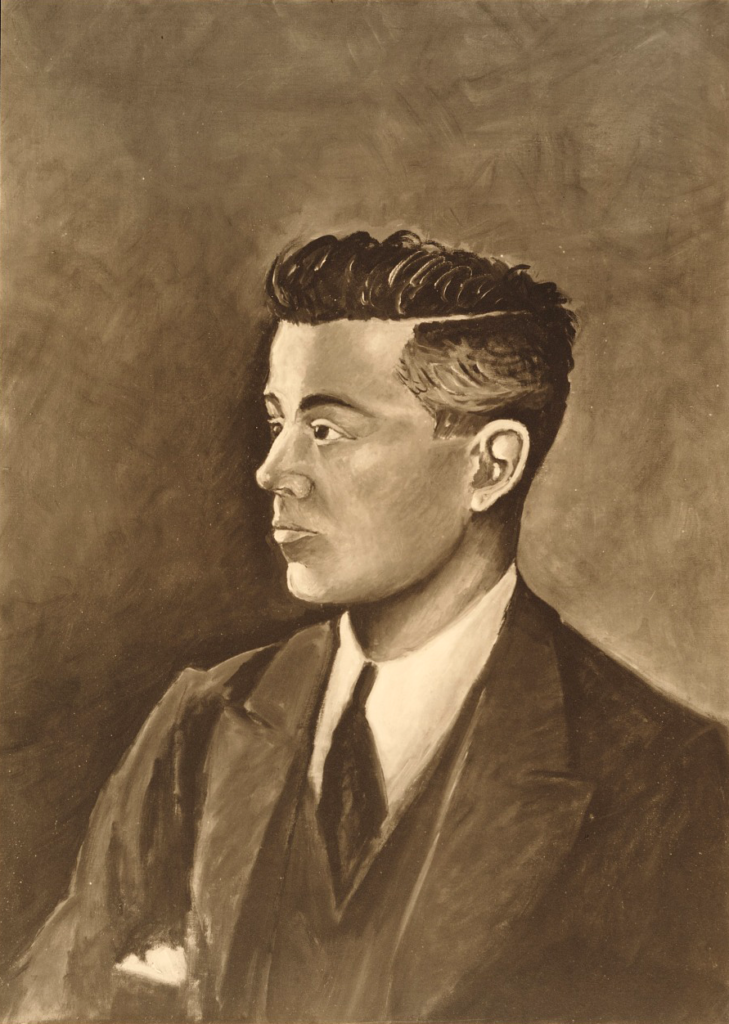
Yes, well, one could assume that. You mentioned before traveling around with Gallatin. Did you travel with anybody else? You know, any of the literary or theatre people that you knew?
Yes, I took a trip to Bermuda with George Nathan once. That must have been the late twenties. Most of my traveling that I have done, ninety-eight percent has been alone.
How many trips have you made to Europe? Do you have any idea?
Oh, I would think between twenty or thirty.
You started so young, back and forth. How did your literary friends take your transition to the painting world?
Well, they seemed to take it in their stride except that of my literary friends; I don’t think there was a single one that really cared a hoot about contemporary painting. Not one.
It is another world for them.
Absolutely another world. It seems curious in a way. I have often thought of that but it is a fact.
I always question the reason for places like Lincoln Center because you have a group of people who go to a concert and a group to an opera and a group to a movie and there is really no rapport or relationship or anything.
There isn’t any connection.
You know, they don’t seem to have interest in other things.
Well, everywhere, even in Paris and so on, the people who were interested in writing were not interested in painting. In Paris more.
Why do you think that difference is — because their culture is more textured?
More elastic, I guess.
Yes.
At the beginning of what we call contemporary art, just before Cezanne say, the writers and painters were sort of together, I think, too.
Well, there were fewer people, too.
And far fewer people certainly. That is one very good reason.
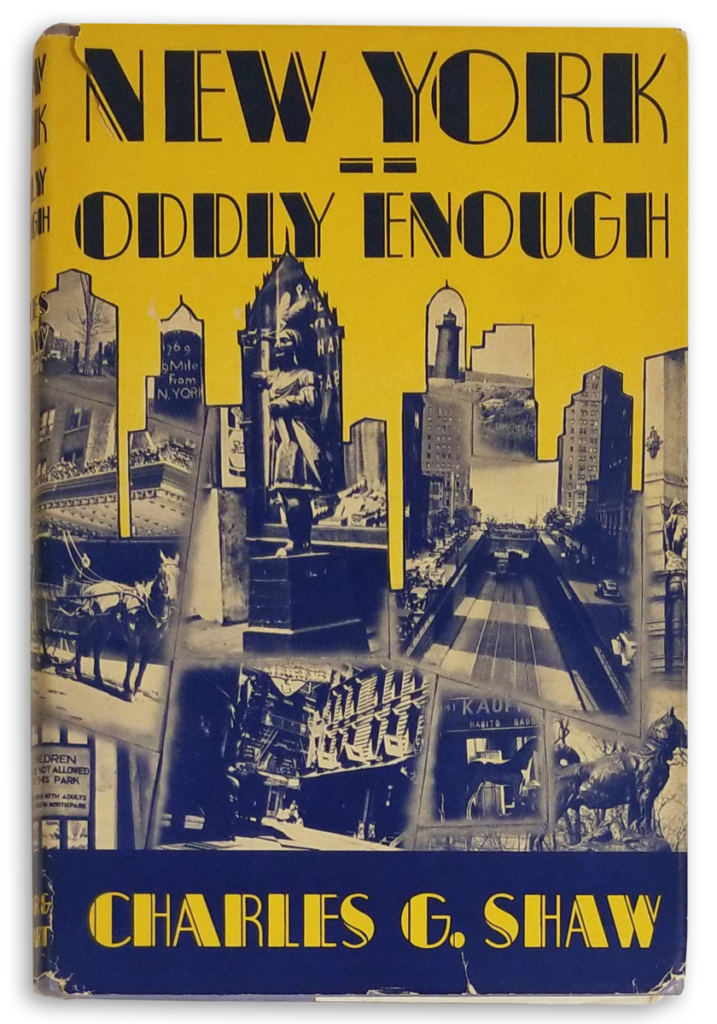
During all this time of writing and publishing so frequently, that must have been the way you made a living, wasn’t it?
Well, I had some money of my own the family left and that came in very nicely except there was not an awful lot of money in it. Well, then to go on with the writing, I was painting from the time after the thirties — the end of the thirties, to be exact it was 1938, Farrar & Reinhart brought out a book of mine called New York Oddly Enough and there are many people trying to buy that book now after it has been dead and buried and they can’t get it. It had a fairly good sale but nothing like I would have liked to have had.
What kind of book was that?
I can show you a copy of it.
Oh, I see it is a…
Curiosities, oddities all over Manhattan from end to end.
New York’s first apartment house on East Eighteenth Street.
That went about five or six years, oh, eight years ago. And that was in l938 and…
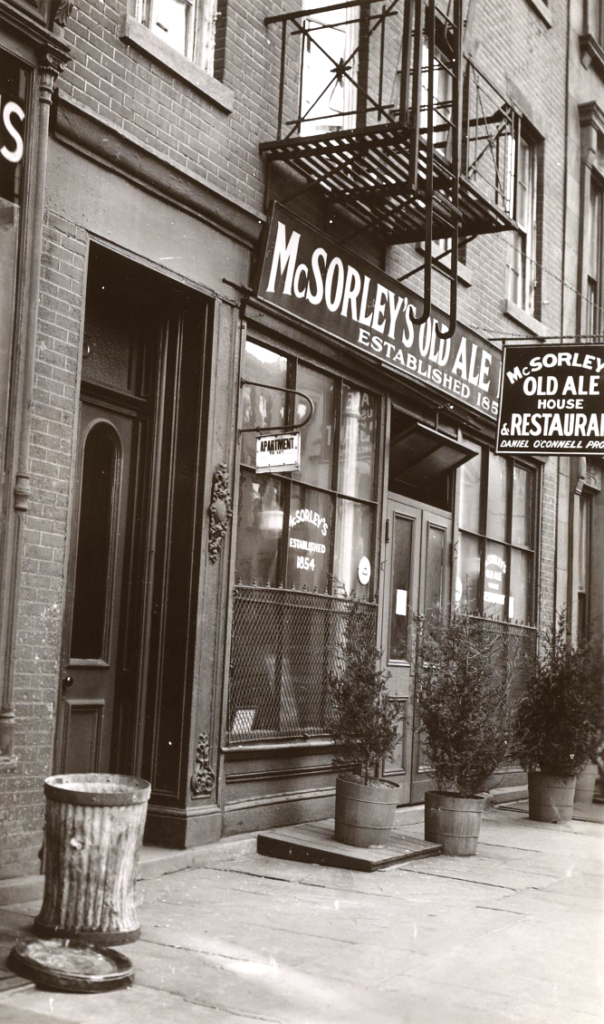
Well, McSorley’s is still there.
Is McSorley’s still there?
Oh, sure.
And the old Merchant’s house is still there, I guess.
Yes.
I suppose about a quarter of them are still left, maybe a third but I don’t think more than a third.
It is very interesting. The streets are so empty here.
Well, I made a point or that, see, because I hate photographs full of people in it and cars.
So you must have gone around on holidays or early in the morning?
That is the idea, of course the streets were emptier then true enough but I did exactly that.
Well, these are all photographs that you took yourself?
Yes, with the exception of two or three.
Yes, out most of them.
Yea, about ninety-four percent.
That is marvelous. I hadn’t seen that.
Two or three friends of mine have been trying to get it lately. You might suggest a place that might have a copy.
It would be pretty hard to find.
The only one I can think of is O’Malley.
Oh yes.
He is the beat one I found. And then my next publications after that weren’t so much later either, were the children’s books. They started in 1940 and went up to 1950, say.
Well, then you started writing poetry about that time?
That’s right.
So you really didn’t stop writing ever, did you?
No, that is true. That is very true.
Well, we mentioned that you published 1500 poems.
Almost 1500 in over 200 vehicles.
That is a full-time job, just writing and sending stuff out isn’t it?
You know it. The hours that takes. And often enough I would get a letter that requires an answer and it is so long that it takes about half an hour to read it and then to form an answer. It is a little rough at times.
Well, how do you publish the poetry? In magazines that you know and little poetry publications?
Yes. They fold up after four or five years generally and new ones sprout up. You take a chance always. And then you find out the type of magazine. That has changed much more in I would say the last five years than it had changed in the ten years set before that.
Yes, I would think so too, terrific change.
The poetry itself is very different, very different.
Well, you mentioned, before we started the tape, the Poetry Society, are you involved with that?
I belong to it, yes.
Have you been a member for long?
I think I have been a member for about I guess eight or ten years. It didn’t seem that long somehow. I don’t go to many of the meetings because I think I told you I am not much of a meeting-goer or committeeman. I used to do it. Maybe one reason I don’t like it as much as I used to—it takes so darn long to get to them now-a-days.
Yes, because they are so far away. Do you go to their lectures and readings and things like that?
Not very often. They have a dinner once a year at the Plaza Motel, before it was the Astor. And they get well-known people from all over the country, Auden and Frost a so on.
Do you know a lot of the poets now?
Well, most of my poet friends I know through correspondence but I don’t know very many in the flesh so to speak. I met Robert Lowell once or twice but I can’t say that I know him at all.
Do you have a large correspondence with writers and people around the country?
Poets, yes. Almost entirely poets. And some of the loveliest letters and most touching letters I have ever received were from those people. I’ve had a number of poems written in my honor.
Oh, really?
Very touching, too.
That is a very rare thing.
I would think so. It is a very different thing from the world of painting. I never knew it existed until I began writing poetry. Not only in the U.S.A., but I got some of these things from England, too.
It sounds as if you still have a soft spot f or publishing things in England, do you? Do you publish anything in…
Well, not very many. I think I would like to much more but I am not familiar frankly with the vehicles there particularly. I know there are many but I’m not familiar with them. In fact, I would like to bring a book out there because I think it would be infinitely cheaper. But I don’t know about their distribution.
Yes, that is always a problem.
That is always a problem and it seems to be becoming more and more so, don’t you think?
Well, I don’t know. There are two or three places in New York that handle poetry books and things like that. Cleveland has a very good book store called the Asphadel.
In Cleveland?
In Cleveland. He handles Jonathan Williams, the Jargon Books.
Yes?
And a lot of things. A terrific place.
Well for instance, Doubleday, Scribners, Brentano, Canton, they handle a lot of my poetry books.
The Eighth Street Bookstore?
I remember asking them once about my other books six or seven years ago and I thought they were rather poor about it. They said they only took people in the Village.
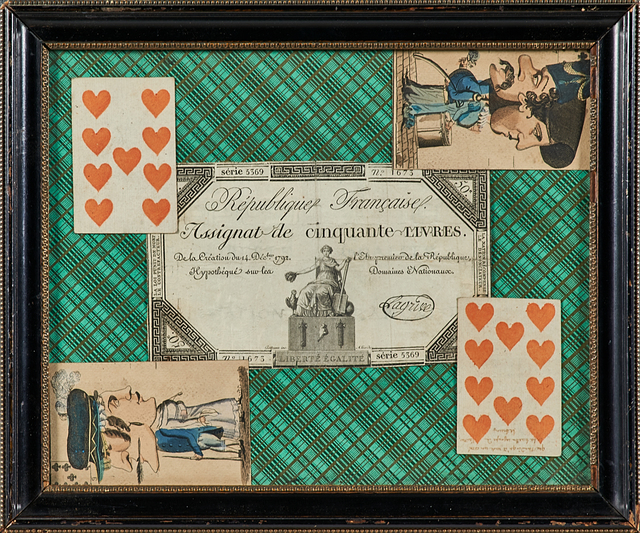
Oh, well, that is not true. I have known them for years. You know, I think we only slightly touched on your other interests and hobbies. You mentioned that you collected cards.
Well, I have collected quite a number of things. The only collection I still retain are these boys here. Tobacco figures. I had magnificent playing cards but I sold them to a dealer.
What other kinds of collections did you have?
And the other collections I had stemmed from the days I lived in London. One was a collection of horse brasses. Do you know what they are?
Yes.
You do? Because very few people do. And I had a very fine collection. They weighted a ton.
Obviously.
I brought, oh, maybe fifty or a hundred I guess back with me. I sold them too. Sold them to a dealer. And another collection I had was of ancient police truncheons highly decorated.
That is kind of unusual.
Quite unusual and I sold them to a dealer about ten or fifteen years ago. And not less than two months ago there was an article in the Times about those — not mine. A magnificent collection sold for fourteen times what mine were. But again I had no place to put them. It would take a rather special house to show them properly.
Where in the world did you find them when you started collecting them?
I found them in London antique shops mainly. I got one from Scotland Yard, a modern one.
How many did you have?
I had about thirty or forty.
That is extraordinary.
And then I have a collection still of pewter. But I don’t do much with it because it originally was for four people to eat off. But not today because the cleaning of it would involve a whole day’s work. I never sold any of the pewter.
How many of the tobacco figures no you have?
I have about fifty and to my knowledge it is the finest collection in the world. I don’t know of any other collection that touches it.
What were they really used for?
They were used the same way that the big ones were.
Oh, you mean the cigar store Indians?
These were the granddaddies. They were used, about half the time, in the shop or in the doorway of the shop but chained to the door.
They are not really very tall, are they?
That fellow there and one in the bedroom [are] taller, but as a rule they were not tall, no. But they are very scarce, today very scarce. Anywhere.
When do they date?
Mine date from about 1700 to 1810. But the figure itself first appeared around 1615, right after Raleigh came back from Virginia.
Well, you have had lots of hobbies, too.
Yes, I have had quite a few. I always liked a hobby that you can dig or pick at that was off the beaten track. These, even when I collected then, which was all of thirty years ago, there were very few places that had them then. And quite a number I got from the tobacco people themselves.
Oh, really? Because I think it is the American Tobacco Company that collects them. They have a tremendous collection of them.
They have big ones, I think.
They have all kinds, everything to do with tobacco. Prints, drawings, sculpture.
Are they on exhibit?
They are in their offices.
Somebody told me now that I …
You can go through there and see them.
Oh, really?
Yes, it is quite extraordinary. I had a tour there.
Somebody told me but I never went around there.
It’s fascinating to see how many places tobacco has appeared in pictures and prints and books and drawings.
Are they well presented?
Oh, yes. It’s really quite something.
Yes, thanks to you I saw that group up at Parke-Bernet.
How did you like them?
Well, they looked all right. They were all so highly varnished, every one. Some of them were very good, others I didn’t care too much for. Was it a private collection? It must have been.
Yes. Every couple of years they seem to find a few and there they are.
Yes.
Do you still have some playing cards left here?
The ones mainly that I have left are the ones I call the montages and I think I told you I sold 500 of them. But it took too much time.
Framing them and mounting there.
Getting the frames made and finding the materials for the background and finding the things themselves.
There is one that is from a set of ivory cards.
That is right.
That is very rare, isn’t it?
Very rare as far as I know.
Did you collect books on cards?
Yes, I bought quite a nice collection right back of you there on that lower shelf. I must have eight or ten books on cards.
Every wall has books on it. What kinds of books are they?
All kinds, all kinds,
You read everything from Houdini to…
That was an interest I had when I was say twelve or thirteen years old. Magic, crazy about magic.
Did you learn magic tricks?
Oh, yes.
Do you still do any of them?
No, hardly ever. Once in a while with a pack of cards or a coin, but I used to be very keen about magic. Magic has sort of died out I guess.
Yes, I think so.
There used to be some marvelous magicians too.
Oh, yes. Great fun.
And in London for many, many years there was a hall — it was called Egyptian hall devoted exclusively to magic. Year in and year out, every week. I don’t know when that ended, pure magic.
You mentioned the Alice in Wonderland books you have.
Those are all firsts.
How did you get interested in Carroll?
Well, because as G. K. Chesterton said, I would have rather written Alice in Wonderland than the Encyclopedia Britannica. And I liked both the Alices and a book that is so unknown today it is monstrous. It is a great piece of literature called the Hunting of the Snark. Marvelous. But I think one person out of a thousand has ever read it.
Yes. I have never seen a copy.
It is a grand book.
The Game of Logic is another one you see.
Well, that was Carroll’s alter ego. That was Lut Dodgson.
Yes, right, his real name.
He did quite a few mathematical books.
Well, he was a mathematics professor, wasn’t he?
Yes.
Are there other areas that really interested you? You have a lot of Shaw.
Yes, I have Shaw and Wells, Chesterton, Wilde, Beerbohm. The Yellow book period — I have a set of the Yellow Book. What do you think of those?
Cruikshank.
Yes.
You still read a great deal?
I still read a good deal but I was telling you the other day most of it after a day’s work is so-called “escape.” To relax. But good writers. I can’t read trash and there are a few and they are always new ones when you exhaust one. Oh, I tried to find out, what did you tell me the nom de guerre of Canaday was?
Oh, Matthew Head.
How many books has he written about?
I don’t know but he has been doing it for a number of years. I guess about one a year.
I never read either another critic who wrote “escape” I believe, he used to be with the New Yorker, art critic.
Coates.
Yes.
Oh, really? I didn’t know that.
He did, yes, under another name. I think he wrote under another name, maybe he didn’t use another name either. Yes, he did. He wrote quite a number.
How did the poetry evolve?
No, I don’t know how that evolved. As I was saying, a number of the things that I wrote for the Smart Set today would go very nicely in poetry magazines. I didn’t consider it poetry at the time and I am sure Mencken and Nathan didn’t.
Well, what kind of a piece would that have been?
Fairly short. Eight lines maybe. Sort of a filler type. You asked about drawings. Well, these were some sketches but we better go onto that later but here is one. This one was a book that never saw the light of publication. But that is in the form of — I wouldn’t call it poetry but verse. And that was before I ever did a child’s book.
You wrote and illustrated this? Right?
Yes.
When was this done?
I would say that was about 1930.
That is pretty surrealistic.
Yes. Quite a few of them are.
Did you ever have interest in surrealism?
More in literature than in painting. I have often thought of that because I don’t think the surreal belongs in paint.
It is really a literary idea for you.
For me it was. And that is why I thought the pure abstract work was so right in doing what they did and making the endeavor to make the spectator forget the subject and think in terms of elasticity of pure art. And these were the later sketch works of the things.
I am fascinated that you can do these two and three things almost simultaneously.
Well, one two, really.
I mean the activity of doing them and then the activity of getting them out into the world.
You see, very few people understand that. They think it is all done by magic. It is very time absorbing.
I know. I know.
And at times very boring.
Did you find that writing the children’s books was a relaxing experience for you from painting?
No. I liked doing the children’s books very much. There is one thing I don’t think I cared too much about was the separation work.
Oh, for colors. Yes. That is mechanical.
That is right. But I did like the books. This is the first children’s book.
Oh, The Giant of Central Park.
Yes.
A mystery story.
There was more of a story to that than most of them. And it was longer too.
How did it sell?
Not too well.
No?
I was very surprised and that was for various reasons. One was that it was a little too frightening which I don’t believe. But it was bought afterwards by Grosset and Dunlap.
Was there any period in your painting when there was sort of biamorphic influence?
Yes, I guess there was, yes.
This is interesting. This one cubist portrait here which is l934. What was his name?
Ernest Boyd.
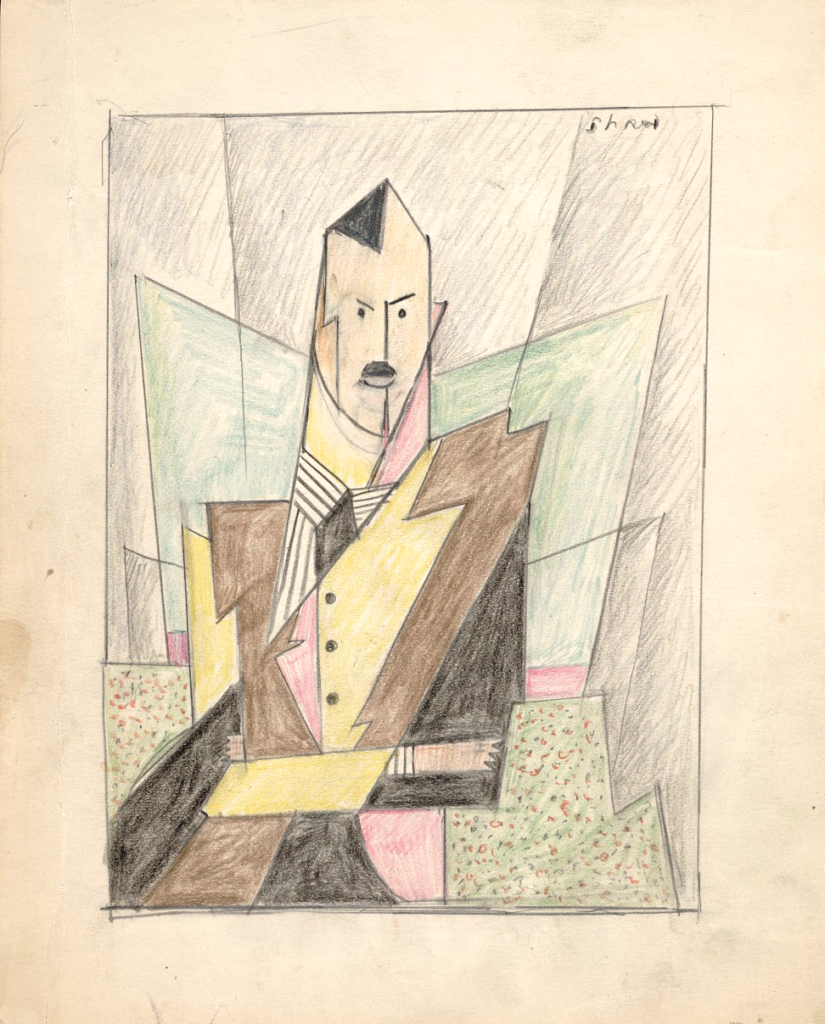
Have you done many portraits?
Not a great many. I did about six or eight or ten cubist ones. I can’t think off-hand of any other portraits at all. I must have done some that I don’t remember. But I was always sketching various people and in one of these books are some sketches I made in Paris.
You didn’t have a very long time when you did figurative paintings, did you?
No, a very short time really. Of course at the League and with George Luks which is not long. Those are the only two classes where I did figurative work.
But I mean soon after that you went into abstraction?
About a year afterwards, yes.
But you continued making little sketches of people?
For example, that was in Paris around 1930.
You have had an interest in color I see — these are very colorful.
Yes, I have always had an interest in color. Oh, yes.
Do you have any theory about color, using color in your paintings?
Well, the best theory I have I learned from the painter Pecquereau that is juxtaposition and certain colors which certainly don’t work at all together. I think the French are the greatest colorists.
How so?
Exciting color.
Because of the nuances?
That is right. At least I say it but today it is pretty international.
Since the war it certainly has been. Everybody goes back and forth at a terrific clip.
Weren’t you asking me the other day about Miss Passedoit?
I was just wondering where she was.
She is off for Paris in a few days.
Yes. I talked to somebody else who has mentioned her so I found out what I wanted to know.
Oh, you found out?
Yes. She really lives in Paris now, she?
No. She lives at no definite place and she’s trying to make up her mind. Now I think she has decided it will be in Paris.
Is there anything more about the writing that you would like to say?
There are all kinds of things but somehow I seem to have put them in the past. It was a different life, it is gone. Gone completely.
Well, how about the writing today? You know, the poetry.
I am very absorbed in that. I spend a lot of time on it every day and almost every day I get some form of communication and I keep track. I keep track of it always and up to date, from the first of the year, I had about 70 poems published. Over the last three years I have had over 200 each year.
That is terrific. That is a lot of correspondence.
It is indeed.
Do you keep a record book and notebooks and things like that?
Yes, and I keep book albums, I must have a dozen or more, of all the poetry that has been published. And I keep copies and some of it is quite difficult because sometimes people won’t publish them for the best part of a year.
They get it and keep it for months and months.
I have one box that has over 900 poems in it — copies of poems that have been accepted but I have never seen in publication. Now I know it is over-exaggeration because I should weed it out more and now I do more than I used to. But still there must be 500 at least that I have never seen.
They are sitting in somebody’s office waiting for the space or something.
Sometimes the magazines fold up. That is the end of that.
You must have quite an archive of correspondence from all these people.
I don’t keep it all but I keep a good bit of it. Again, to do all that I would have to have a trunk. I frankly keep it mainly for reference sake.
Well, but after a point maybe you don’t use it anymore. You always refer back and forth?
That is true to a point, yes.
That was very interesting looking at those sketches which were still figurative but the paintings of course were abstract things by the ’30’s.
Well at that time I wasn’t doing much painting. I was writing a book then — finishing a book.
How do you work today? Do you write poetry in the morning or paint in the morning?
My schedule more or less is to do a little painting in the morning, no writing until the afternoon, generally the late afternoon. Painting in the morning and in the early afternoon and then in the late afternoon the poetry for two or three hours. And then during the news period from six until quarter to seven I will paint in gouache. But not at night. Now and again I will write at night but as a rule I will read escape things.
You mentioned that you belong to the Century Association; they have certain activities that go on there, don’t they?
Yes. I have a painting on view there practically all year round. In the various shows.
Are there any other societies or organizations like that that you are involved with now?
All the other ones I belong to are the Abstract Artists, the Federation and Artist Equity, but I never go to the meetings any more. Hardly ever.
When did you join Artist Equity? That has been around for quite awhile.
Toward the beginning. I never went to a meeting though.
Wasn’t Bob Gwathmy involved with that? Do you know him?
I never met him. I know his work but I never met him. A lot of people I knew were involved with it but they got out somehow. At least they got out of their involvement.
Carried the membership on but didn’t do anything. I see. The other thing that we just mentioned a minute ago, you really then have not had outside jobs. You have made a living from writing and painting.
The only outside jobs I had were the very beginning. One was in sort of a travel office and my job involved writing notes, travel notes and things.
When was that?
Oh, heavens it must have been — oh, a long time ago. Before World War I. Another one that lasted even less than that was in an architect’s office. That was right after I left Columbia. That came to nothing and I am glad it didn’t. And then I began writing. I wanted to write all the time then. Oh, another one and that lasted longer now that I think and that was real estate. That lasted about a year and a half.
Oh, what did you do in real estate?
I made several sales but it didn’t catch me at all. Not at all.
What were you doing, selling houses or buildings?
Country houses and New York apartments and things.
When was that, again early?
That was the year immediately after the war, 1919. Those are the only jobs I ever had.
So since 1920 really it has all been painting and writing. That is great. There have been a lot of people who had such a terrific time getting things going.
Yes, I know that.
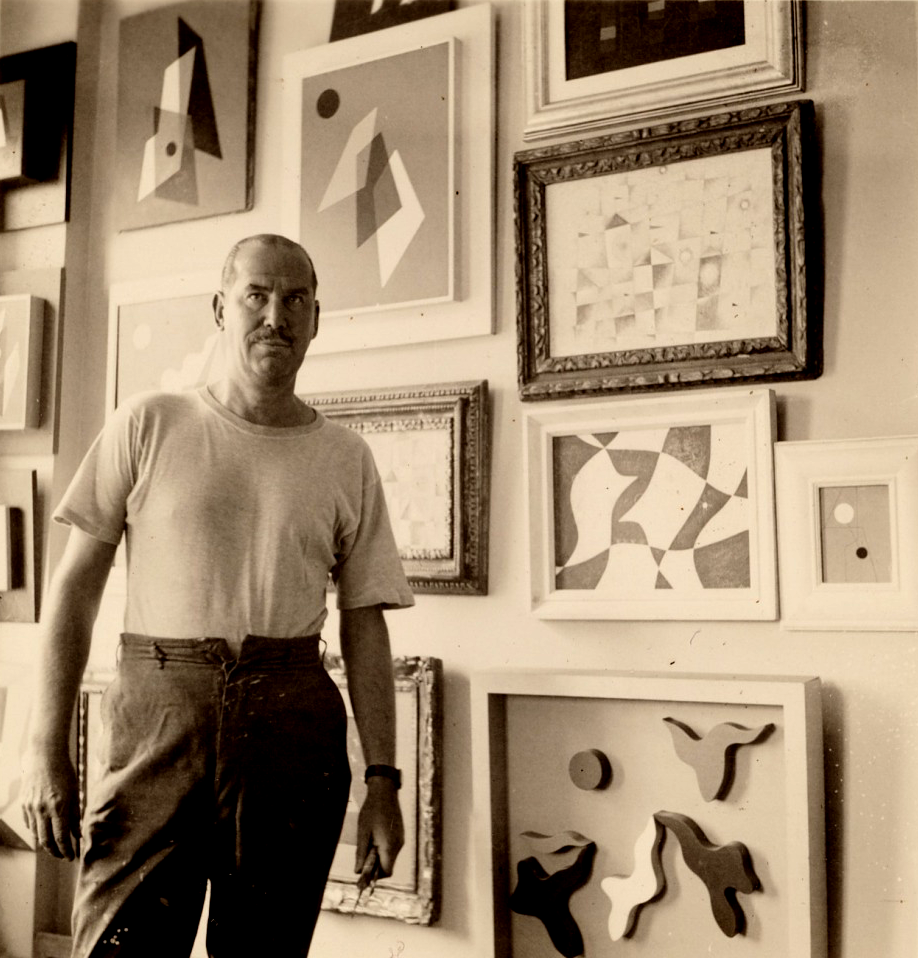
You mentioned one thing I thought was interesting; you said that Passedoit sold paintings for you very well in the forties?
Some in the mid-forties but she did much better in the fifties. Much better. The one or two shows I had before, in ’45 and ’46, she did well with.
That must have been kind of unusual then, selling abstract paintings. There weren’t too many galleries around.
That is true enough.
And not too many people who are really aware of them.
Very few people are aware of them.
Non-figurative painting.
Well, the first show I had with Dudensing at the Valentine Gallery, he did quite well in selling paintings of mine.
Thirty-four.
Thirty-four. In ’38 there weren’t so many sold. They were better paintings.
Do you know or remember any of the people who bought pictures from you then?
Well, I think there were many people I knew. One was a Mrs. Ulrichs who bought two. One was a Mrs. Lambert, one was a Mrs. Lewisohn. I can’t think of any others.
I am quite interested for the reason that there were so few exhibitions of abstract painting and most of the people just put the pictures up and then they took them down again.
Well Gallatin bought a few of my paintings, too, in the thirties.
Well, he was one of the few people who…
Very few. And that applies to his friends, too. I remember one of the first times I met him he said do you know many people that are interested in abstract art? I don’t. As you say, it took them a long, long time.
Yes.
Awful long time.
George Morris was involved quite early with these…
Yes, and George has a fine collection now. He formed a fine collection very early. Picasso, Braque and so on. He was very good about buying paintings from contemporary people, colleagues.
Just a few minutes ago we were talking about color and you were saying how good the French were. Don’t you think that their use of color in abstract painting is quite different?
It was. I have seen very little abstract painting of the French recently. Very little and from what I hear it has fallen off. But it was magnificent in the twenties.
Do you frequent the galleries much these days? Do you go around and see things?
Fairly well, yes. To see more would be impossible.
Oh, you can’t.
I get around fairly well. That is, for the work I am interested in. I am not apt to go see classical work and figuration work or pop.
How about some of the op painters, do you like them?
Some of them are quite fine, yes.
Are there any younger painters that interest you particularly that you can think of?
I am afraid I can’t off-hand. I know there are some good ones, though.
Which galleries do you go to?
Well, I am apt to go to for instance Bertha Schaefer, Betty Parsons, and Rose Fried and not very often to Graham.
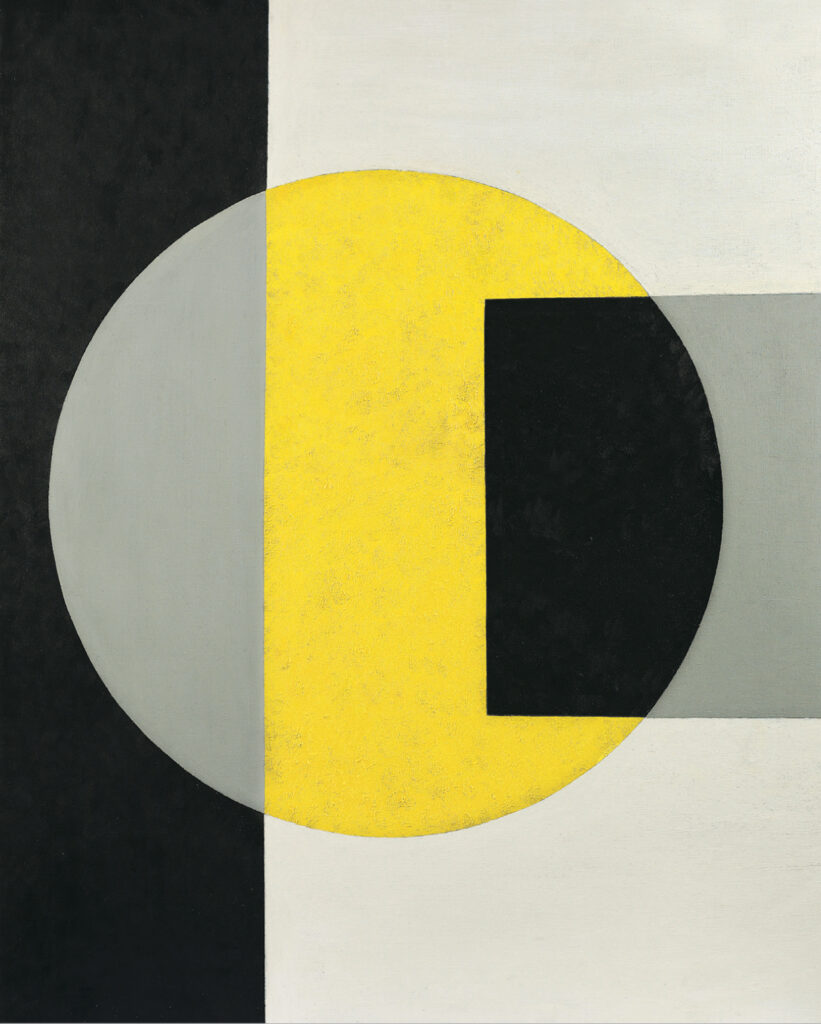
Do you go to Marlborough or Pace?
Once in awhile. Emmerich. But I don’t get up very often to the 70’s or 80’s. The Willard Gallery I go to occasionally but not very often. Viviano.
You sort of just go right across Fifty-seven Street.
Pretty much so.
Well, how do you like the painters who stain? Speaking of Emmerich Gallery he has Noland and Frankenthaler.
Not too much because I like more texture in a painting I think for one. And frankly a good many of them I see no development in their work for twenty years.
Same thing over and over and over.
Blown up.
Yes. Or vertical this year and horizontal next year.
That is my feeling all right. And also a good deal suggests carpets and rugs or awnings. Which is all right up to a point but a painting needs a little more than that. A little further push.
Have you seen any of the minimal people?
I have seen their work and some of it looks pretty good, too. In painting I do. I don’t care for it in sculpture.
Oh, really?
No. because so many just seem to be a box or a plaque. Again, it isn’t pushed far enough. Over simplification and all that. I tried to get on it myself but it needs more than that and it’s not good enough.
What is the more that it needs?
Well, it would depend on the thing itself. It is hard to say. It needs something more. Maybe not too much but it is too simplified, too nothing. The worst example I saw I thought was in that sculpture show at the Whitney Museum about a year ago. The end. The end.
In what sense?
Quality.
In the making or the ideas or…
The projecting and the way it was shown. I don’t know who the chap was that did it. It was an object about half as big as this room, a cube was all it was.
It didn’t interest you?
No. A good carpenter can do a better job.
Well, they are supposed to be a little rough, you know, that adds the personal touch to it.
I saw nothing personal about it. Nothing. But I think some of the minimal things are — I think it is a good approach I must say. And when it. comes off I think it’s grand. It doesn’t come off all the time — but nothing does.
Well that is true. I saw the last time in the studio that you had some shaped canvasses.
Yes.
That had rectangular cutouts or inserts or extensions.
They aren’t canvasses.
They are wood.
Wood. Yes, those go back to ’34.
Did you do very many of those?
I think I did about a dozen or so. I showed them for two or three years. I showed quite a few at the very first show of the Abstract Group at the Squibb Building in ’36.
Oh, yes.
I showed half a dozen then.
What kind of a reaction did you get?
The only reaction I got outside Gallatin buying one or two was Henry McBride. He wrote a very nice mention saying something about the museums will snap them up right away. There was no snapping up whatsoever.
Well, have you seen some of the people now who make shaped canvasses?
Yes. I hate the curved ones — I mean the three dimensional ones. I don’t care for them at ail. At least I haven’t seen any I like yet.
Why didn’t you continue those?
I don’t know exactly. I think one reason I didn’t because it took up a little space. But I suppose one of the reasons I didn’t continue was because nothing happened to them. They didn’t move.
What kinds of comments did you get from the artists at the exhibitions? Were they interested? Because there weren’t too many shaped things then.
I think they were, yes. Of course, as you say, in the days, ’36, very few people would buy abstract work at all regardless of their shapes. Very, very few. In New York I think Paris was not doing too badly. Picasso and Braque weren’t.
Well yes but they still had figurative qualities in a lot of their work.
And Leger wasn’t selling at all in those days.
Mondrian, of course, wasn’t — nothing was happening to him.
Absolutely nothing. And Miro could be bought for very little. Very little, indeed.
Not any more.
Not any more.
You also showed me some collages. When did you start doing them?
I did them back in the early thirties in Paris. They were papier collages mainly. But then I began doing them with various fabrics around 1952 I think.
Schwitters exhibited collages back in the early twenties. Did you know any of the other people? The cubists had used occasional pieces of material.
But I didn’t count them. Schwitters goes back quite far with his I think.
Yes, had you seen any of those?
No, I don’t think so. The only ones I remember were the Picasso and Braque ones.
The collages I saw here were quite different from the cubist use of collage material.
Yes.
Were the early ones like that too?
I think they were rather like that. Some of them were quite simplified. Some were made out of magazine things. I did do quite a few I suppose.
Were they done as experiments or studies?
They were experimental but they were finished in themselves. I never pursued them.
They weren’t really a step into painting?
No I don’t think so.
You stopped doing collages for quite a period. Or have you just done them on and off since.
On and off maybe. I did them in the early fifties but I hadn’t done them before that for a good ten years. At least I don’t think so. I don’t think I had any in the shows until the fifties.
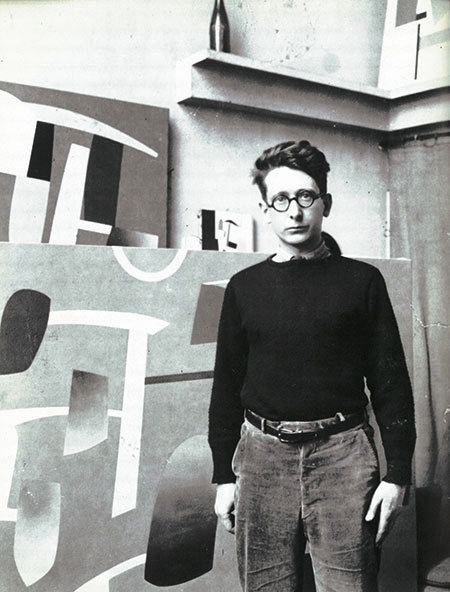
You had mentioned briefly that Jean Helion was a good friend of yours.
Yes. I saw quite a lot of Helion in Paris. And he was doing magnificent abstract work. I think next to the Picasso-Braque group he was by far and away the best, quite marvelous and he was by far the best man in France, I think,
How did you find him? Where did you meet him?
I think I met him through Gallatin. I am pretty sure. And in those days I saw quite a bit of Ferren in Paris, too. Ferren was living in Paris. But I saw a lot of Helion.
Well, he did some writing, too, didn’t he? Didn’t he write about art occasionaly?
He wrote occasionally. He also wrote a book which I didn’t read about his war experiences. He wrote, I think, for a magazine. It was pretty good, too. Published in London. He wrote more than a few articles for that and I can’t remember the name of it. It was quite well brought out too and it was almost entirely abstract. And that was back in the middle thirties.
I think Herbert Read was involved with that.
I think so. I don’t think it ran very long.
I think there was one issue.
No, there was more than that. Yes, there was more than one. But not more than two or three.
Were there any other artists that you knew in Paris very well or saw frequently?
I would say off hand possibly one or two. No, I couldn’t have known them very well because I would remember. I think that Vitlacyl was working there but I knew him later. I didn’t know him in Paris. And Holty was there also. But I knew them both later.
After you came back to New York?
Yes.
Were you ever interested in Helion’s ideas or theories?
Yes.
Do you ever use them?
No. I have always been very leery of that, of using another fellow’s theories.
Thinking about them or adopting them?
Adopting them. But I admired them very much. I thought it was splendid work and I thought it was very sad that he didn’t pursue that direction.
Now he is doing figurative painting. Did you see that exhibition at the Gallery of Modern Art?
I didn’t see it but I saw reproductions. But I saw his show last year.
Oh, at the Willard Gallery?
Yes.
The early paintings are marvelous, aren’t they?
Yes.
Very fresh.
Absolutely. As I say, I don’t know why he didn’t continue that.
How would you describe the former content of your work and its evolution?
That is a pretty big question. There have been various phases but I think in principle I stuck to certain ideas, feelings more, of solidity, impact. And lately over the last three or four years — simplification very much. Very much. Also in every painting I have ever painted I endeavored to have a balance. It was held together. It didn’t fall apart and go out to one edge as so many of the abstract expressionists do.
But that is what they want to do. Envelop the world.
But so much of it was bad painting for that reason. Now there are a few, very few in my mind, who are very good fellows, very good painters, who did not do that. But there are not too many of them. They were in the vast minority. And they were very good but they were just letting things slop. Anybody can do that after all. And I think a sense of color is very important, but I am a great admirer of the black and white work, where black is used as a color.
It is interesting that people who are involved with abstraction tend to be quite interested in black and white.
Have you found that?
Yes. Whereas figurative people don’t really understand it. They do in drawings maybe but they can’t get it to work in pictures. And they rarely will do black and white pictures. I worked on a black and white exhibition about a year or two ago.
Abstract?
They all turned out to be abstract.
But it could have been anything?
Yes.
That is quite interesting.
It was just the idea to see what there was in the last few years that was black and white.
That is very interesting indeed. I think abstract work lends itself to black and white.
Well, because you get different spatial feelings and weight feelings.
Spatial feelings and also, like in any abstract work, the design is very important. Now as we know in a deft non-obstructionist representational painter can produce a painting that looks superficially very good. But when you pick it to pieces it doesn’t hold because the design is not good. And that applies I think to many great names.
How would you define what design is? Because that is a word you don’t hear too much anymore.
No. Well, the composition. I would say it involves balance terrifically.
You mean balancing color and line and shapes?
Everything. Which is not an easy task.
Well, it is tensions, too.
Tension, absolutely true, and very important. Tension is most decidedly.
The earlier work that you did is really quite flat, you know, the geometric work in the thirties. Very flat. Kind of hard-edge, one color plain abutting another one.
Yes.
But recently I have noticed your shapes have gotten involved with curves.
That is true. But in the last year they are purely hard-edge. Not rectangular but angular, in which I feel they have the qualities I am after: impact, movement and simplification plus texture.
The texture is kind of new, isn’t it?
Yes, that is true.
When did that start?
Well, for that sort of painting it was within the last year, about a year.
Do you know what started that?
No.
Because there are very articulated surfaces on the recent pictures.
No, I don t know what started that. I think we got started with that question when you asked me about the minimal painters and sculptors. Without that it wouldn’t be enough, not nearly enough. It needs something more.
You mean just a large, flat shape isn’t as interesting as one that has some life to it?
Unless something extraordinary happens to that shape — which I haven’t seen happen and maybe it can’t happen to anybody I’ve seen. But it has to have something more than just that big shape. I don’t care if the canvas is a mile big,
Well, your paintings haven’t ever really been huge, have they?
Never huge, no. For the simple reason I haven’t the space for them. And the gallery, Passedoit, didn’t have room for a big painting, a really big one. Not too many galleries around do.
Well, Schaefer handles pretty good size canvasses.
Well, I have some canvasses about as big as I have seen there. Nothing like Emmerich for example.
Have you ever tried large canvasses or just don’t they interest you?
I would try tomorrow if I had the space. Not even in Nantucket. That place isn’t big enough. Even if it were the problem of transporting them after they were finished.
You roll them up and shift them around.
I hate a rolled canvas. I have done it and I hate to do it. Oh, yes, I have done it more than a little.
Do you have a house in Nantucket?
I stayed there at the Inn and if I go I will probably stay there again this summer but before that I had always stayed for many years at a native’s little house. It was very nice but I had one big objection and that was going out for every damn meal.
Did you have a studio to work in up there?
No, a friend was kind enough to lend me his studio. But as a rule for the last few years I have done just small work. This stuff here. That sort of thing.
Those little ones?
Yes, that sort of thing.
Right.
In gauche and then when I come back home I make canvasses from them.
Well, that is nice. You get a break out of the city and different kinds of things to work in, work with.
That’s right.
Do you accept any association with neoplastic painting or with any of the schools of abstraction? In association with. Like there are some painters who say I am a neoplastic painter. Do you ever feel that you were involved with any of the groups particularly?
No. In fact on the contrary. I always tried to endeavor to stay clear of…
Of all the organized aesthetics and really develop your own.
Endeavored to develop my own. I know there is great feeling about not being individual today.
Well, not too much but just enough.
I can’t think of a painter off-hand who was any good who I consider wasn’t an individual.
Oh, well that is true.
Not one.
Have you ever written about your own paintings?
No.
Never sat down and made notes about them or formulated ideas?
No, I don’t think I ever have.
It is very interesting because of all the writing not to have ever written about the painting.
Once I pick up a pencil to write painting is way off.
Really? It is just another…
Another world
It is another environment.
A different state.
That is interesting. You have never done art criticism or anything like that? Haven’t written any of it.
No, I don’t think I have ever written art criticism. I have written for art magazines but I can’t remember what I wrote now. It wasn’t criticism. Judged a show last year but, no, I have never done art criticism. I have been asked to more than once but it is not my cup of tea.
Have you juried exhibitions before?
I have done it two or three times.
Do you find it interesting?
No. Frankly, no.
It really doesn’t offer very much.
At one exhibition I helped judge with some other fellows — there were 500 paintings. You feel afterwards that you made a lot of mistakes. But that is bound to be with anything like that.
Yes. You had mentioned another thing, that you were interested in psychic phenomena.
Very much so and I still am.
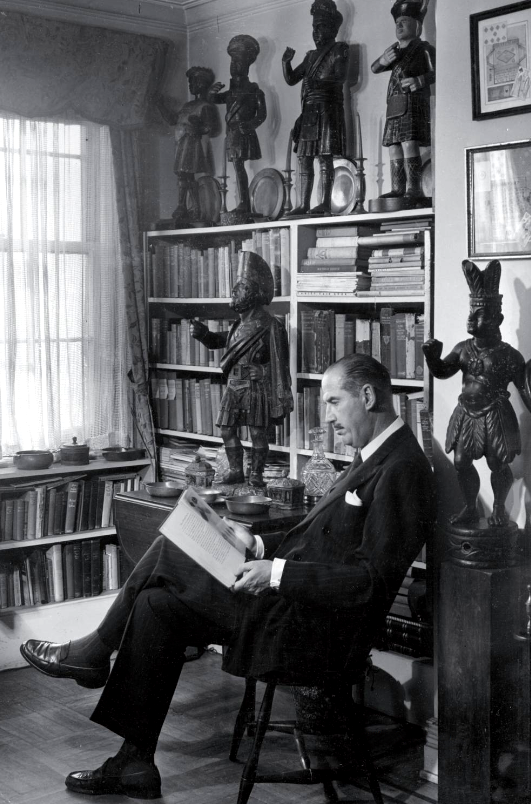
And read a number of books. When did that start?
I would say that started around 1950. No, it went a little earlier, about ’45, just after the war. I can’t pin it on any reason.
Were there people you knew who were involved in it?
Yes, I have known a good many people with odd experiences. They are very funny — people, about such things, you know. I have known examples of people who had lived for many years in this village around the corner from each other and they both had very strange experiences they never told each other. But I’d find out from each one. But they are very coy about mentioning it. They are afraid that people are going to think they’re crazy.
Yes.
Incidentally, on the radio last night there was a man, I shan’t mention his name, he has written books. But he alleges that Dr. King’s assassination was known completely before by a man who gave the name of the hotel, the time and everything.
All this turns up afterwards.
Yes. Apparently this person was a woman, had the document in her hand and she didn’t do anything about it for no reason.
I always find it strange that it turns up afterwards.
Well, one could say the same thing about Nostradamus. In fact, everything practically everything because those quatrains were so wrought that it made very curious reading and difficult reading. But once the thing happened it was as clear as day but before that it wasn’t clear at all. It was very ingenious writing. But he predicted the event more than a few times including the proper name, the person.
I haven’t read anything of his for a long time.
I haven’t either for quite a while. I suppose he is in paperback, I don’t know really.
I don’t know, I don’t think so.
Weiser would have it if anybody. The next time I am up that way I will stop in.
There was once years ago a bookstore on West Canal Street that had all the material on Nostradamus.
Not really?
Yes, and I don’t know if it is there anymore.
I bet it isn’t.
But it was the south side of Canal Street over by the Post Office.
And they specialized in Nostradamus?
Yes, and a terrific amount of material. I mean really going way back.
To get away from Nostradamus, the first printed bound books they often enough have contained the earliest playing cards.
Oh, really?
Because paper was quite scarce and in the spine of the books say — before they were cut. Small sheets of them.
Right. Right. To be used as binding.
And the earliest cards were found that way.
That is amazing. Printmakers like to get old books and cut the end papers out and use them for prints.
But there have been more than a few people who have predicted amazing things in advance. As you say it seems a little odd that people don’t — well, they make a record in terms of proof. This woman said she had the postmark of the letter in which it came and it was a week or two ahead.
That is interesting. You mentioned before the books that you had read and some of the authors that you were interested in. I know that there are various societies involved in psychical research.
The only one I think I can really give a good mark to is the Society of Psychic Research in London. The other ones I don’t know much about.
Well, Duke University has gone through all kinds of…
Dr. Ryan. Yes. But it is quite narrow — it is in one little field. The others have embraced every conceivable field and over a period of years. They had very good people and some of them wrote extraordinarily fine English language. Very articulate and very to the point and really quite fine phrasing too. And they accepted practically nothing unless it was proven up to hilt over and over again.
You still have interest in that?
Oh, yes. Well, I don’t read much because I haven’t heard anything that is worth reading. Now I am sure Weiser could produce some good things that I don’t know about. The last book I have heard, or read rather, was a book called The Imprisoned Splendor and a very first rate book. But that was published at least ten years ago I would say by Raynor Johnson.
Did you ever get involved with the Bridey Murphy controversy? Did you read about it?
Yes, I read all and I just think it was too bad because it all turned out to be a hoax. There is too much of that. It isn’t a part of psychic phenomena but of life, facts, that so many peop1e in that field are not strictly on the level. And that applies I am afraid to about ninety-five and one-half percent of professionals. Now it’s understandable why is does because a professional, assuming the professional has those gifts, in order to retain a clientele they can’t say well, if you come back Tuesday I may be all right. See, it’s like a lawyer or a doctor. . .
They have to be there.
They would be finished. And in order to keep going they have to make passes every now and again which is unfortunate. Now there is one beautiful example of that of a woman called Giuseppa Paladino, a Neopolitian peasant, illiterate and didn’t know quite how to say right from wrong but she had these extraordinary gifts and she wanted to live and feed herself. And she worked under Flammarion in Paris time and again. And Flammarion testified time and again she caused the most astonishing things to happen. And the boys in Cambridge asked her to come over and they caught her making a pass and instead of accepting it they said the whole thing is all rubbish. You see, that is too bad it happened because she did have these extraordinary gifts. Amazing. But she was a professional. Now as far as I know there are only about three or four professionals I have ever heard of, if that many, who were never unmasked and always did very good things.
Who are they?
One was a Mrs. Piper in Boston. One was one of the most extraordinary characters that ever lived, called Daniel Douglas Hume. He was born in Edinburgh and at the age of fourteen he was sent to America and he was with his aunt, and the aunt couldn’t take the goings on. So she sent him back to England, he had no money at all, and in some extraordinary way in London he went to a place called Cox’s Hotel where I have stayed more than a few times in London. It is no more. And Mr. Cox presented him to two men and from then on he sailed through life with no worries or cares. He married two ladies, names, and was never unmasked.
That is amazing.
And he was with Crookes in London. Crookes testified that this man caused the most amazing things to happen. And the poet Browning wrote a very scurrilous poem about him called Mr. Sludge, the Medium.
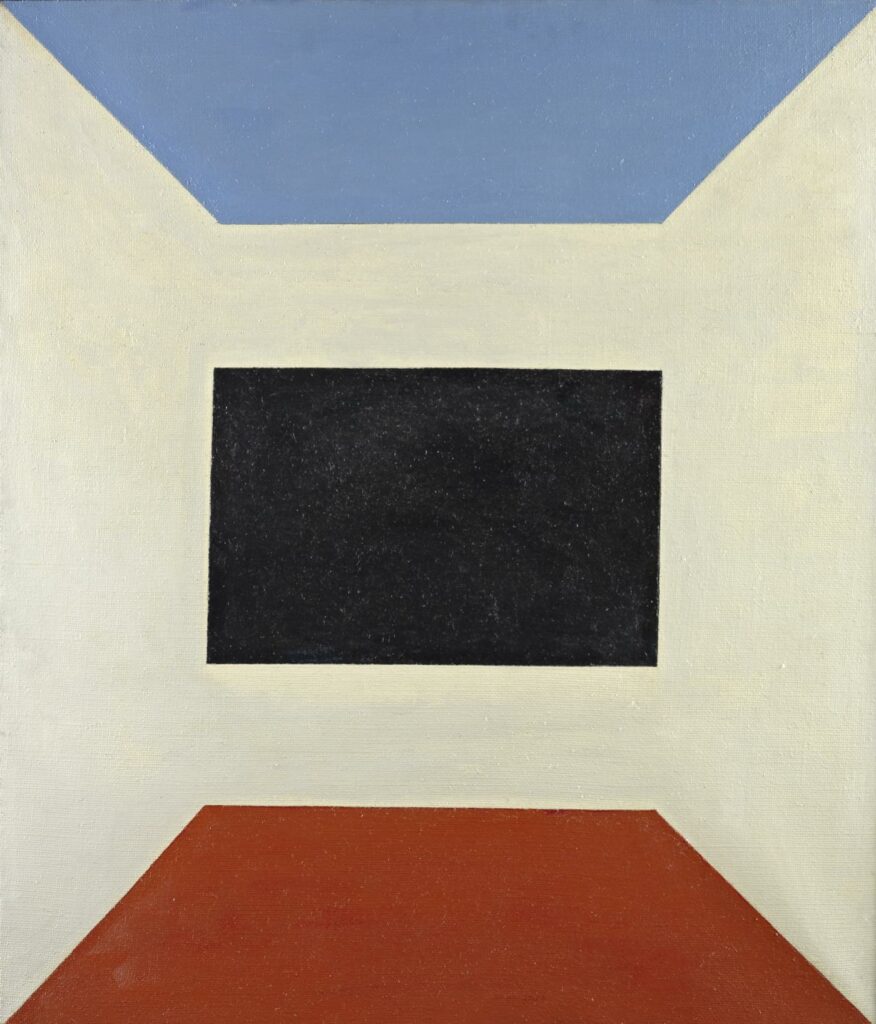
Oh, that is who it is supposed to be.
That’s the one. Mrs. Browning was all over him, crazy about him. He wasn’t allowed to go to Rome because his powers were too great. And he ended up living in London and the most extraordinary feat of them all was that he was in a room four stories up, a corner room, and there were four men who came down to testify and to tear him to rags. Hard-headed chaps, maybe scientists, but maybe not all. Each one of those men afterwards testified to the fact they saw Hume lying down on the couch, levitate himself, go out one window, go around the corner and come in through the other window. They saw that. And Frank Podmore was one of the main leaders of this Society Psychic Research. He said there are only two answers to that performance of Hume. One was that four men, hard-headed men were hallucinated and the other was that it happened. But he was an extraordinary character. He had very bad lungs too but he seemed to survive until the mid or late sixties and he was never detected at all.
That is interesting. Are there any contemporary people that have been…
Yes, but I take a dim view of most of them because frankly I think that all the stuff I have heard is not good. They don’t examine it properly. They accept too much on one hand. On the other hand they are apt to denounce it before it begins. I think that some people have, I am sure more than a few, have these amazing powers. All over the world. But the greatest of them all in a sense were the great sages in India, Even up to the moment. Out of the population of India, how many millions, there are only probably two or three there. But they are a dedicated people and I think they do have powers. But if one could produce ten people here that witnessed this fact in a room, they would say they were all hallucinated. If you got a hundred, they would say the same thing. So where are you? Now there is a man called Price who wrote three books on a haunted house in England, the Rectory. He spent twenty-five years in examining the facts and he presented his material at the end to one of the most eminent jurists in England. And the eminent jurist said that in a court of law the evidence that he had furnished him with would hang a man. Well, if you could hang a man why don’t the other people accept the thing? If you are going to hang a man on such evidence why can’t you accept it as a fact? But they won’t. They won’t, you see.
Yes. Well, it brings into question too many other things.
It turns around then. In other words it was circumstantial evidence perhaps. Witnesses testify they saw this happen. Well, people I know have been hanged for that. If ten people saw a person assassinate a man I think he might be electrocuted. That is the same thing, if they saw him, isn’t it?
Yes. Well, but that doesn’t call into question the fact of mediums, say.
That is unfortunate. The medium thing is unfortunate. Because there is so much hocus-pocus there. So much. No doubt about that. Also a great many people write books on the subject and the ones I have read are not first rate. They are not convincing to me at all. But it is a marvelous subject and they haven’t scratched the surface of it.
Well, there never are really very many people who are actually engaged in it. So that’s always a problem.
But see the academic boys are against it all. Now not so long ago there was a lady who gave quite a lot of money to a very eminent university, which will be nameless, for a Chair in that subject. The money was accepted but the Chair was never formed.
Yes.
They don’t like that, they’re afraid of it.
Interesting. What university was that?
What?
What was that, a New York university?
No. I would rather not mention the name. A university in New England.
But they’ve got all those free thinkers up there, it’s amazing they can’t drive it through somehow.
No.
Well, I just wonder what else we could say about the painting.
I am afraid there is an awful lot about the painting during those years and up till today almost that somehow I don’t keep in my mind. I forget them. They will come up again, pop up again, but at the moment I can’t dig them out.
Actually we have more or less covered the topics here as a matter of fact.
Yes, I would think so. Yes.
